

Jharkhand Culture and Tradition
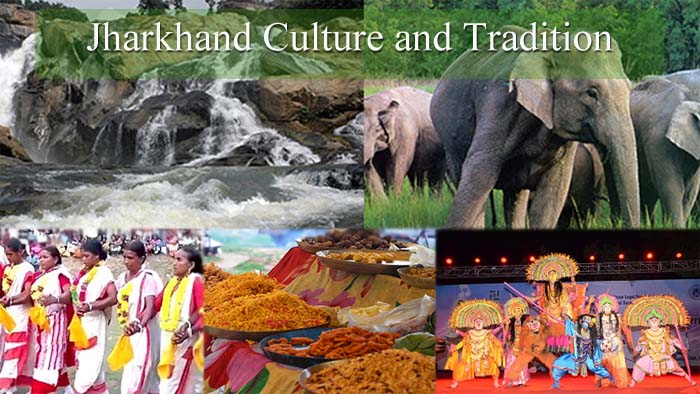
Jharkhand is an eastern state of India, which was carved from the southern part of Bihar on 15th November 2000 after a long and protracted demand for a separate State. Jharkhand borders state of Bihar in the north, Uttar Pradesh and Chhattisgarh in the west, Odisha in the south and West Bengal in the east.
Jharkhand is the fourteen largest state in terms of population and the 15th largest state in terms of area. Ranchi is the capital and Dumka is the sub-capital of the state while Jamshedpur is the largest and the biggest industrial city of the state. Some of the other major cities and industrial centers are Dhanbad, Bokaro, and Hazaribagh.
Due to its abundant mineral reserves, it is also called as “ Rur of India “, Rur is a mineral state. Jharkhand has more than 40 percent mineral wealth of the country, and mining and mineral extraction are the major industries in the state. Jharkhand is famous for its rich mineral resources like Uranium, Mica, Bauxite, Granite, Gold, Silver, Graphite, Magnetite, Dolomite, Fireclay, Quartz, Feldspar, Coal (32% of India), Iron, Copper (25%of India), etc.
Despite having so much mineral wealth 40 percent of the population of this state is below the poverty line. The majority of the population of the state is in rural areas only 24 percent of people lives in cities. The rural population is dependent on agriculture and rice is the major crop cultivated in the state.
The name “Jharkhand” means “ The Land of Forests ” as the most of land is covered by forest. Jharkhand has underlined the distinctive tribal heritage and culture of the region as the primary reason for alternative administrative and political arrangements.
ADVERTISEMENT
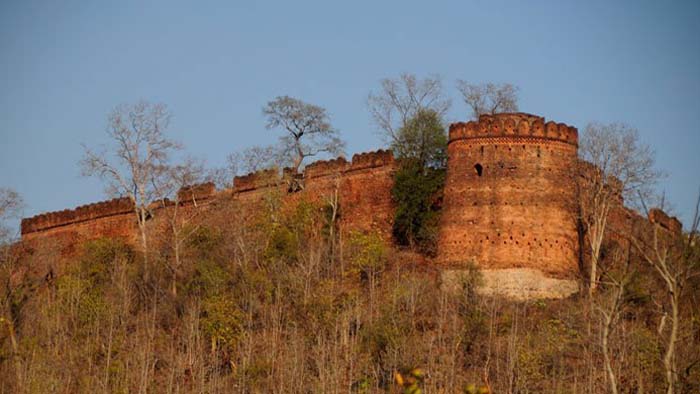
Jharkhand has a unique geographical, demographic and historical composition. According to some historians, there was already a distinct geo-political & cultural entity in the area which we know as Jharkhand even before the period of the Magadha Empire.
The description of Jharkhand is also found in the Vedic books, Jharkhand is called Muranad in Vayu Purana and it is known as Mund in Vishnu Purana. The Chota Nagpur region was known as Pundarik during the Mahabharat period. In some Buddhist texts, there is a description of Chinese Buddhist monk Faxian coming to India. Faxian was a Chinese Buddhist monk who traveled by foot from China to India, visiting many sacred Buddhist sites. Jharkhand has also been described by the Chinese traveler Yuwan Chwang , the Iranian traveler Abdul Latif and the Iranian religious teacher, Mullah Bahbahani.
History of Jharkhand state is more than 100 years old, Indian hockey player and captain of the Indian hockey team in Olympic Games, Jai Singh Munda, in 1939 AD, thought of merging some southern districts of present Bihar state into a new state. However, this dream of Jai Singh Munda came true on 2 October 2000 when the bill to give separate statehood status to Jharkhand was passed in the Parliament, and then on 15 November the same year, Jharkhand became the 28th state of India.
Historians believe that this region was also marked as a unit even before the Magadha Empire because the geographical, cultural identity of the region was different. The state of Jharkhand is considered to be a natural place for tribal communities, who have been given the status of Scheduled Tribes in the Indian Constitution.
Among them, Khadia, Santal, Munda, Ho, Oraon, Asura, Birjia, Pahadia, etc. are prominent. The credit of making the forests of Jharkhand clean and cultivable and habitable to humans is given to these tribal.
Before the Muslim rulers and the British rule, the tribal took over the system here. In the Munda practice of these tribal, a head was appointed in the village called Munda and the messenger of the village was called Dakuva. Later during the Mughal Sultanate, this state came to be known as Kukra State.
After the year 1765, this area came under the British Empire. During the subjugation of the British Empire, the tribal of this place were tortured a lot and the influence of the people coming from outside increased. Due to increasing atrocities, day by day many revolts were also carried out by the tribal, some of which are as follows.
Paharia revolt
The Paharia movement was started by the tribals of the state of Jharkhand against the increasing British atrocities on them, which lasted from the year 1772 to 1780.
Manjhi revolt
Tilka Manjhi was a tribal Yodha who raised her voice against the atrocities of the British rule. Tilka Manjhi was born on 11 February 1750, Tilka continued her rebellion against the British power from 1772 to 1784 without any surrender. Manjhi started a rebellion against the atrocities of the British Empire, which was called Manjhi rebellion, this rebellion lasted from 1780 to 1785.
Tamar revolt
This revolt was led by Dukhan Manki and this revolt lasted from 1795 to 1800 AD.
Munda revolt
This rebellion was led by Vishnu Manki and this rebellion also-ran like the Tamar rebellion from 1795 to 1800 AD.
Munda revolt under the stewardship of Dukhan Manaki of Tamar
The Munda tribes have periodically launched movements against the atrocities of the British Empire in the state of Jharkhand, in the same order, there was a rebellion by Dukhan Manki which lasted from 1800 to 1802 AD.
Chero revolt
Like all rebellions, this rebellion was against the British rule, it was started by Bhukan Singh of Palamu.
Bhumij revolt
Bhumij revolt under the leadership of Ganga Narain of Birbhum started in 1832 and continued till 1833.
Santhals revolt
The Santhal tribes, which are mainly found in Jharkhand, West Bengal, Orissa and Assam, revolt against the Governor of Bengal, Lord Cornwallis. This rebellion was called the revolt of the Santhals.
Second Santhals revolt
The second revolt of the Santhals was done under the leadership of Sidhu Kanhu. This revolt started in 1855 and lasted till 1860.
Sepoy Mutiny.
This rebellion was the first armed rebellion against the British Empire led by Shaheed Lal, Vishwanath Sahadeva, Sheikh Beggars, Ganpat Rai, and Budhu Bir. This rebellion started with arson and sabotage but the rebellion took a huge form. And by the end of this rebellion, the rule of the East India Company had ended and the direct rule of the British crown began.
Kherwar Movement
The Kherwar movement was started in 1874 under the leadership of Bhagirath Manjhi. Bhagirath Manjhi was the son of Tilka Manjhi. Tilka Manjhi was hanged for waging a rebellion against the British Empire, after which Bhagirath Manjhi led the Kherwar movement.
Munda Revolt
This rebellion was also part of the Munda rebellion which was carried out by the Munda tribe from the 18th century to the 20th century. This rebellion was led by Birsa Munda , Birsa was born at a place called Ulihatu in Jharkhand. There was a great movement called Ulgulan in Jharkhand under the leadership of Birsa, people of the Munda tribe still worship Birsa as God .
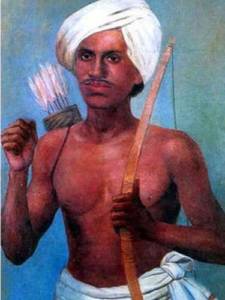
Apart from all these revolts, many more revolts were carried out against the British Empire but they were made useless by the Indian British Army. Mahatma Gandhi was greatly influenced by Tana Bhagat heartening freedom struggle, and after which Mahatma Gandhi started the Civil Disobedience Movement
In the year 1765, this area became subordinate to the British Empire, the East India Company started enslaving the people of Jharkhand region and started oppressing them, as a result of which the people of the region got a sense of rebellion against the British Empire. The revolt against the British broke out in 1857, but the tribal here started a revolt against the British almost 100 years ago.
The tribal made several revolts from the British Empire to protect the land of Jharkhand. Tilka Manjhi first waged a revolt against the British Empire, in 1796, a tribal leader Sant Lal redeemed his land from the landlords and the British Government and Pledged to restore the land of ancestors. The British government sent its troops and crushed the revolt of Tilka Manjhi
In 1797, other tribes also revolted against British rule. After this, the people of the Chero tribe in Palamu started a revolt against the British Empire in 1800 AD. Seven years after this rebellion, in 1807 AD, Orens killed their great master of Srinagar in the west of Gumla in the Barway. This thing soon spread to Gumla and surrounding areas. People of the nearby Munda tribe and people spread in Tamar areas also revolted against the British Raj.
In the Revolt of 1813, Gulab Singh was holding a land transaction but then in 1820 he openly started rebelling against the landlords and the British. It was known as Laka Coal Rings 1820 -1821. Then came the great Cole Rising and this rebellion was done in 1832. This rebellion was a major revolt by the tribes of Jharkhand, this rebellion greatly disturbed the British Empire. In 1855, the Santhal Rebellion started under the leadership of two brothers Santhal and Kannu. These rebels greatly disturbed the British rule, but then later the British government also crushed them.
After all this, the rebellion of Birsa Munda started. In this rebellion, the people of the Munda tribe revolted in Khunti, Tamar, Sarwara and Badgaon belts. Munda Rebellion was the largest and longest-running tribal uprising of Jharkhand.
In the Chota Nagpur division, the British government faced many rebellions, the opponents of the British government adopted the policy of divide and rule wherever they existed. The British government tried its best to suppress and rule the tribals, but the tribals also strongly opposed it and protected their wretches.
After the Chhotanagpur Tenancy Act 1908 to protect their land, the tribals thought of doing social and economic development of the people and in 1920 joined the Satyagraha movement of Mahatma Gandhi and stopped the government from giving the land. The Simon Commission came to Patna in 1928 when the tribals demanded a separate Jharkhand state, but their demand was turned down. After this, Thabal Oron organized the Kisan Sabha in 1931 and then in 1935, the Unnati Samaj and the Kisan Sabha were merged in Chautalagpur to gain political power.
Culture and Tradition of Jharkhand
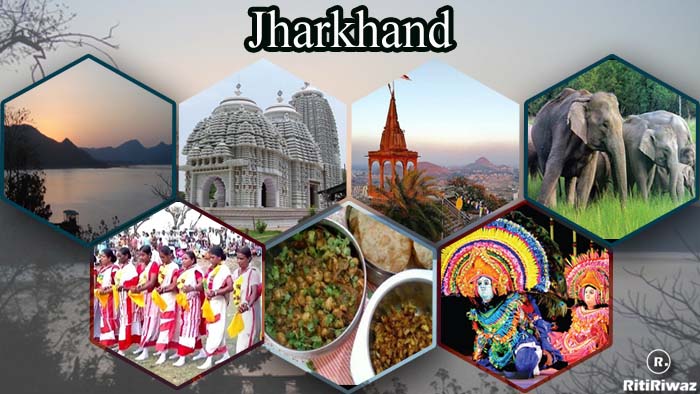
Many tribes have inhabited this part of the country because of which the state has emerged as an important multi-ethnic state. Jharkhand has about thirty indigenous communities among which some of the major tribes are the Santhals, Oraons, Mundas, Kharias, Hos, and Cheros.
The state is a blend of various tribal cultures, people are influenced by Buddhism and Jainism, the Mughals and Hindu kings. The culture of the people depends on the community to which they belong, which influences there living style, rituals, dance, music, language, and literature.
Being a tribe dominated state each sub-caste and tribe have its own unique tradition. Nature has been given the utmost importance in every sphere of life and culture. The life of tribal people is reflected in their folk dances, paintings, music, dance, and drama.
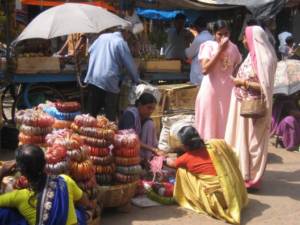
The state is situated on Chota Nagpur Plateau with many rivers like Damodar, Brahmani, Kharkai, and the Subarnarekha, flowing gently adding natural beauty and the taste of the elegance of nature. Jharkhand is a place to explore the mild hills, valleys, and riverbeds with endless opportunities for exploration.
Jharkhand is one of the richest regions of India in mineral resources, about 40% of the country’s mineral wealth is found here but the region is still plagued by poverty, social injustice, corruption, and sporadic outbursts of Maoist and Naxalite violence. Although with the influence of modernization things are changing fast, still the tribal people have retained their traditional way of life.
Suggested Read: Culture and Tradition of Indian States
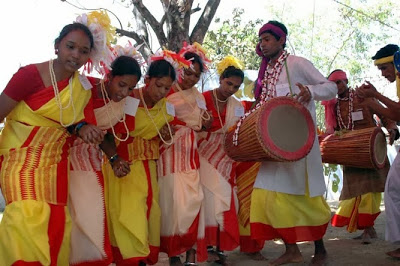
The communities of Jharkhand have a rich culture and tradition with several colorful festivals. Branches of scared trees are brought and ceremonially planted in the courtyards. Devotees then worship these tree parts associated with gods and goddesses. Karma puja, Jitis puja , Sarhul are a few of these examples.
Poush Mela or Tusu Fair is a significant occasion celebrated during the Makar Sankranti wherein brightly colored and decorated artifacts of folk deity are carried by the people. This is a folk harvesting festival. Tusu is a folk belief, not about any God or Goddess, but about a sweet little girl of the tribal folk. The festival takes place as new crops are harvested.
The official language of Jharkhand is Hindi and is mostly spoken among people while the state converse in a number of other languages like Bengali, Angika, Kurukh, Mundari, Santali, and Ho.
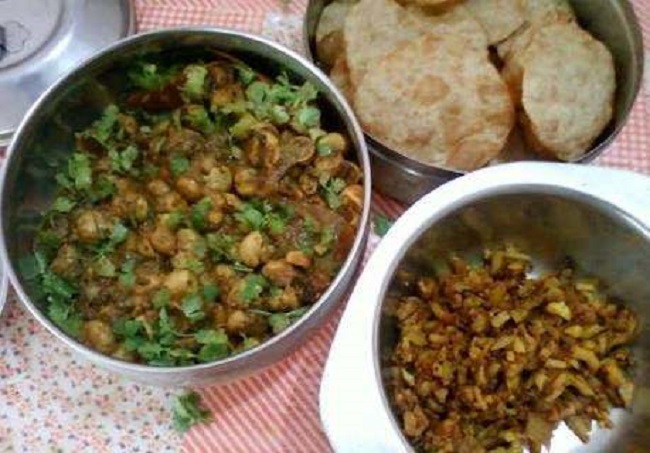
The popular cuisines include local varieties such as Arsa, Dhuska, Chhilka, Koinar Sag, Grenn Sag, Dubki, Udad Dal, Kurthi Dal, Litti-Chokha, Sattu Paratha, Pitha, Khapada, Roti, Arsa, Mitha Pitha, and Kudurum Ki Chatni are famous. The food is not much different from its neighboring states Bihar. They prefer to eat wheat, rice, and vegetable cooked in Sunflower Oil and Mustard Oil.
Dhuska is a dish made from rice. Dhuska is prevalent in tribal houses. Some of the non-vegeterian food are Mudwa Khussi Meat, Duck Meat, Deshi Chicken and Tengara Fee.
Litti is famous dish of Jharkhand served with Baigan bharta and Aloo Bharta. Jharkhand Pitta is made of rice and has its own flavor. Rugdha, Chilka Roti, Mal-Pua, Bamboo-shoots, ThekuaAaloo Chokha, Till Barfi and Khaja are also very popular.
Suggested Read: Famous Food Of Indian States
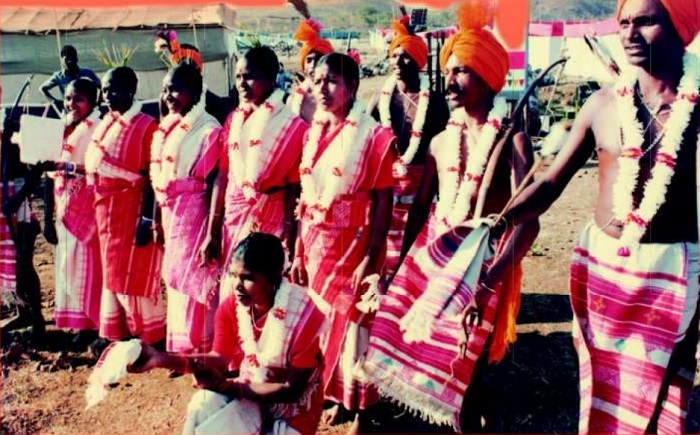
The women’s clothing in Jharkhand is saree and blouse, you can find high-class Tussar silk sarees here. Tribal women usually wear Parthan and Panchi. While the non-tribal women wear modern costumes or sari with a blouse. Women love to wear gold and silver jewelry which are mostly beaded ornaments.
Bhagwan is a single piece of cloth worn by men. The Santhal Pargana tribe men wear Santhals and Paharis to give them a unique look. While men also wear kurta -pyjama or dhoti while shirts and trousers are also worn.
People of Jharkhand harbor a love for perfumes and their aromas and you can find people applying a variety of perfumes.
Suggested Read: Traditional Dresses Of Indian States
Music and Dance
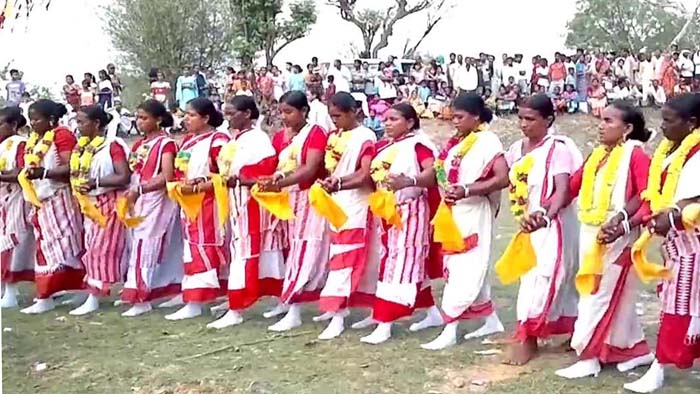
Tribal people of Jharkhand (Mundas, Santhals, and Oraon) are born dancers and singers. There are song and dance at every get-together, they have their own musical instruments and the traditional tribal costumes and jewelry worn by the dancers.
Some of the popular tribal dance of Jharkhand are Hunta Dance, Mundari Dance, Barao Dance, Jitia Karam, Jenana Jhumur, Mardani Jhumur, Seraikella Chhau , Ghora Naach, Domkach, Laha Suya, Jhitka and Danga.
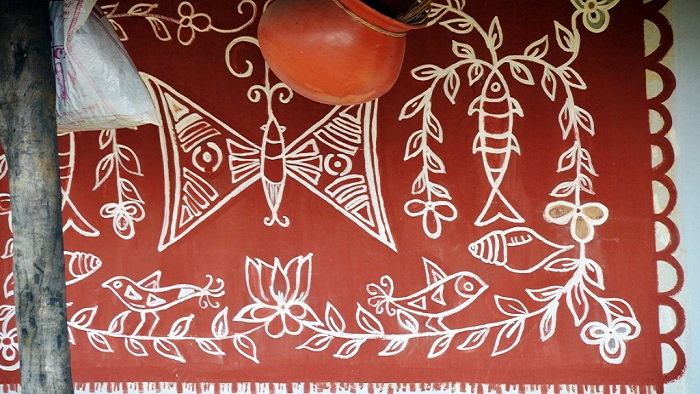
The Jharkhand area is famous for a special type of folk painting called the paitkar paintings. This form of painting is one of the earliest forms of tribal paintings in India and thus enhances the culture of Jharkhand.
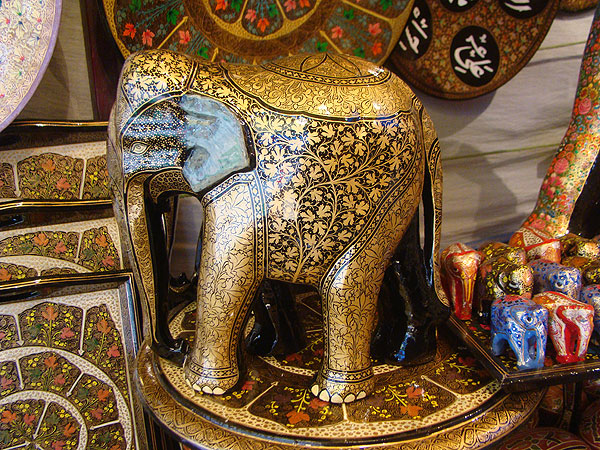
Jharkhand is a treasure house of arts and crafts and hand-looms. You can find clay elephants, pots painted in brilliant hues and embellished with rural motifs, foot-scrubbers, clay figurines, jugs and masks of variety.
During Navratri Bengali craftsmen flock Jharkhand to make idols of Durga, Kali, Saraswati, and other deities, from bamboo, straw, clay colors, tinsel, pith, and other decorations. The ‘painted mask’ tradition of Jharkhand is truly legendary. In the early days, masks were made of leaves, but today’s highly stylized masks use a variety of materials like wood, pumpkin, gourd, cloth, even paper masks.
Dokra, the ancient metal crafts which have caught the interest and attention of the worldwide artistic community, is practiced by the Malhar and Tentri tribes of Jharkhand.

Go to Jharkhand , and explore the mild hills, valleys, and riverbeds, the mines and minerals are aplenty but so are the beautiful things. You will find amazing people outside the cities, the local brew is called handia, Sal Forests, Project Tiger at Betla, the Kechki river confluence near Betla, then Netarhat, Amjhoria, Horhap. The tourist facility is minimal and you will find very few tourists in the area.
There are numerous mountains, ghats, waterfalls, nature and the wide undisturbed coastline that make it a heaven for anyone with a desire for natural beauty. In Jacinta falls will find quiet bubbling waterfall, very safe, not too much water, some great rock climbing around it, the water is clean enough to drink and if water can taste heavenly.
Baidyanath Dham – One of the 22 Jyotirlingas of Shiva.
Jain pilgrimage center at Parasnath Hill
Betla (Palamau) National Park
Jubilee Park – Unique Park built on the Golden Jubilee of Tata Steel.
Shikharji mountain peak – the highest peak in Jharkhand.
Methon Dam – one of the 10 tallest dams in the country.
Rock Neck – one of the most beautiful gardens in the country
Naulakha Temple – Built at a cost of nine lakhs
Hundru waterfall – the tallest waterfall of Jharkhand at 98 meters high.
Tata Steel Zoological Park – Wild Animal Park
Betla National Park – Tiger Reserve located in the Chota Nagpur Plateau.
Hazari Lake – Velvet meadows located in Hazaribagh
Kanhari Hill – Beautiful view of the entire Hazaribagh from the towering tower
Surajkund – Hazaribagh hot water reservoir
Famous people from Jharkhand state
Mahendra Singh Dhoni – Famous Cricketer (born in Ranchi) Meenakshi Sheshadri – Hindi film actress (born in Sindri) Priyanka Chopra – Famous Hindi film actress (born in Jamshedpur) Tanushree Dutta – Famous Bollywood Actress (born in Jamshedpur)
Suggested Read: Formation Dates of Indian States
Simmi Kamboj
Related articles.

- Indian Festivals
Mother’s Day 2024: SMS, wishes, greetings, WhatsApp message and Facebook quotes

Happy Baisakhi 2024: Wishes, Messages, Quotes, Images, Facebook & Whatsapp status
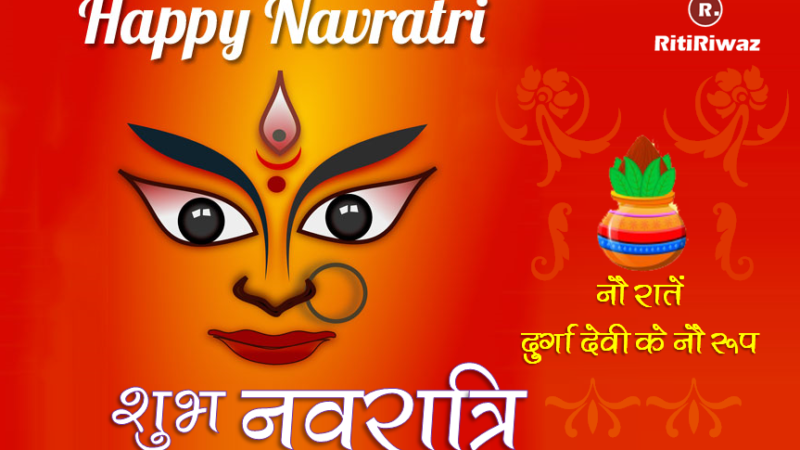
Happy Navratri 2024: Wishes, Messages, Quotes, Images, Facebook & Whatsapp status
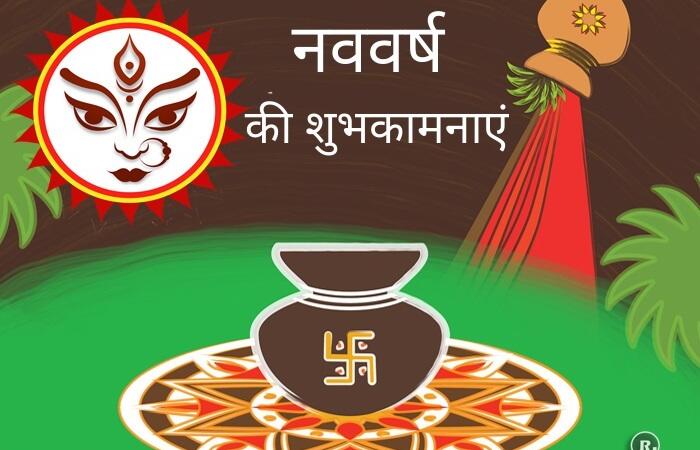
Hindu New Year 2024 – Wishes, Quotes and Message

Easter 2024: Wishes, Quotes and Messages

Good Friday 2024 – Good Friday Messages, Wishes, Sms, Image
Ritiriwaz - riti riwaz, ritiriwaaz, riti riwaaz, culture, india, indian, traditions, rituals, custom, hindu, sikh, muslim, islam, marriage, wedding, festivals, travel, lifestyle, beauty, fashion, recipes, food, immigration, living abroad, monuments, places, palaces, forts.

Cultural Symbols || Rituals || Social Culture || Personal Culture
JHARKHAND- CULTURE

Essay on Jharkhand – 100, 500, 1000 Words, 10 Lines
Essay on Jharkhand: The essay on Jharkhand provides a comprehensive exploration of the state’s historical significance, cultural diversity, economic landscape, and contemporary challenges. From its tribal heritage to its industrial growth, the article delves into the unique identity of Jharkhand, showcasing its natural beauty, vibrant traditions, and the complex interplay between tradition and modernity.
The essay unfolds the state’s journey, emphasizing its contributions to India’s resource sector and the ongoing efforts to address socio-economic issues. Readers will gain insights into the multifaceted character of Jharkhand , a state at the crossroads of tradition and progress.
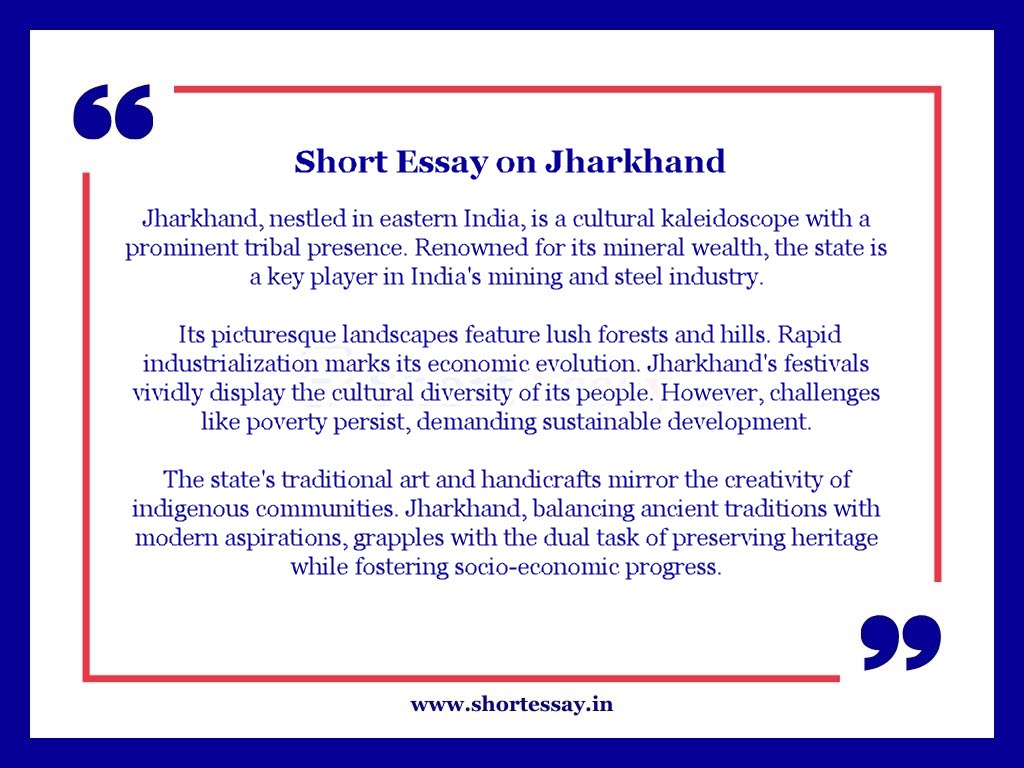
Table of Contents
Essay on Jharkhand in 10 Lines in English
The essay on Jharkhand encapsulates the state’s rich tribal heritage, economic significance, and contemporary challenges, highlighting its unique blend of tradition and development in India.
- Jharkhand, in eastern India, is culturally diverse, with a substantial tribal population.
- Abundant in natural resources, the state plays a pivotal role in India’s mineral industry.
- Its landscapes boast lush forests, picturesque hills, and a rich biodiversity.
- Rapid industrialization, especially in mining and steel, has reshaped its economic profile.
- Jharkhand’s festivals showcase the vibrant cultural tapestry of its people.
- Despite progress, challenges like poverty and displacement persist, necessitating sustainable development.
- The state’s traditional art forms and handicrafts reflect the creativity of indigenous communities.
- With a unique identity, Jharkhand balances ancient traditions and modern aspirations.
- It faces the delicate task of preserving heritage while embracing socio-economic progress.
- Navigating contemporary challenges, Jharkhand remains a significant contributor to India’s development.
Jharkhand Short Essay – 100 Words
The short essay on Jharkhand explores its rich tribal culture, economic significance in minerals, and the delicate balance between tradition and modernization in eastern India.
Jharkhand, nestled in eastern India, is a cultural kaleidoscope with a prominent tribal presence. Renowned for its mineral wealth, the state is a key player in India’s mining and steel industry.
Its picturesque landscapes feature lush forests and hills. Rapid industrialization marks its economic evolution. Jharkhand’s festivals vividly display the cultural diversity of its people. However, challenges like poverty persist, demanding sustainable development.
The state’s traditional art and handicrafts mirror the creativity of indigenous communities. Jharkhand, balancing ancient traditions with modern aspirations, grapples with the dual task of preserving heritage while fostering socio-economic progress.
Essay on Jharkhand in English in 500 Words
The 500-word essay on Jharkhand offers a detailed exploration of the state’s cultural diversity, economic significance in the mineral industry, scenic landscapes, and the ongoing challenges and initiatives for sustainable development.
Jharkhand, situated in eastern India, unfolds a narrative that blends cultural richness with economic significance. Home to diverse tribal communities, the state boasts a unique cultural tapestry. The vibrant festivals and traditional art forms showcase the creativity and heritage of its indigenous population.
Jharkhand’s landscapes, adorned with lush forests and picturesque hills, contribute to its natural beauty. However, the state’s true economic prowess lies in its mineral wealth, making it a key player in India’s mining and steel industry. This economic transformation has altered the socio-economic landscape, bringing both opportunities and challenges.
Rapid industrialization has been a defining feature of Jharkhand’s recent history. The state’s mineral-rich soil has attracted significant investment in sectors like mining and steel production, propelling it into the forefront of India’s industrial hubs. While this development has spurred economic growth, it has also brought forth challenges such as environmental concerns, displacement of tribal communities, and the need for sustainable resource management.
Jharkhand’s festivals, deeply rooted in its cultural heritage, offer a glimpse into the diversity of its people. The celebratory spirit of festivals like Sarhul and Karma reflects the harmonious coexistence of tradition and modernity. Traditional art forms, including folk dances and crafts, add to the cultural vibrancy, emphasizing the rich legacy that the state strives to preserve amidst the winds of change.
Despite its economic strides, Jharkhand grapples with persistent challenges. Poverty, particularly in rural areas, remains a concern, demanding targeted developmental efforts. The state is also confronted with issues of social inequality and displacement due to industrial projects. Addressing these challenges requires a delicate balance between economic progress and social welfare, ensuring that the benefits of development reach all sections of society.
Jharkhand’s tribal communities, with their distinct languages and customs, contribute significantly to the state’s identity. Their way of life, deeply intertwined with nature, reflects the symbiotic relationship between the people and their environment. Efforts to preserve and promote indigenous cultures are crucial for maintaining the unique character of Jharkhand and fostering a sense of belonging among its diverse population.
The state’s economic and cultural evolution is complemented by its breathtaking landscapes. Jharkhand’s national parks and wildlife sanctuaries, such as Betla National Park, are havens of biodiversity. Conservation initiatives play a vital role in preserving the rich flora and fauna, contributing to the ecological balance of the region.
In conclusion, Jharkhand stands at the crossroads of tradition and progress, navigating the complexities of modernization while safeguarding its cultural heritage. The state’s journey is a testament to the resilience of its people, who embrace change without losing sight of their roots.
As Jharkhand continues to forge ahead on the path of development, the challenge lies in fostering inclusive growth that benefits every section of society and preserves the essence of this unique and culturally diverse state.
Essay on Jharkhand in 1000 Words
The 1000-word essay on Jharkhand provides an in-depth exploration of the state’s cultural diversity, economic significance, environmental challenges, and efforts towards sustainable development in eastern India.
Jharkhand: A Tapestry of Culture, Economy, and Sustainability
Introduction
Jharkhand, nestled in the eastern part of India, unfolds a captivating narrative that weaves together cultural diversity, economic dynamism, and the imperative of sustainable development. This essay embarks on a comprehensive exploration, delving into the state’s unique identity, its journey from tribal heritage to economic prominence, and the challenges it faces on the path to sustainable progress.
Cultural Kaleidoscope
Jharkhand’s cultural richness is a testament to the diversity of its people, particularly its vibrant tribal communities.
- Tribal Heritage: The state is home to numerous indigenous tribes, each with its own language, customs, and traditions. This section explores the unique cultural heritage of Jharkhand’s tribal communities, emphasizing their integral role in shaping the state’s identity.
- Festivals and Celebrations: Jharkhand’s festivals, like Sarhul and Karma, are steeped in tradition and showcase the celebratory spirit of its people. This subsection delves into the cultural significance of these festivals, offering insights into the rich tapestry of Jharkhand’s celebratory traditions.
- Traditional Arts and Crafts: The state’s traditional art forms, folk dances, and crafts contribute to its cultural vibrancy. This part of the essay explores the creativity and craftsmanship of Jharkhand’s indigenous population, underscoring the importance of preserving these traditional expressions.
Economic Significance
Jharkhand’s economic landscape has undergone significant transformations, primarily driven by its mineral wealth and industrial development.
- Mineral Hub of India: The state is a powerhouse in India’s mining sector, with abundant reserves of minerals like coal, iron ore, and bauxite. This subsection analyzes the economic impact of Jharkhand’s mineral wealth, tracing its journey to become a key player in the country’s resource extraction.
- Industrialization and Steel Production: Rapid industrialization, especially in sectors like steel production, has propelled Jharkhand into the forefront of India’s industrial hubs. This part of the essay explores the economic implications of industrial growth, highlighting the opportunities and challenges it presents.
- Socio-Economic Challenges: Despite economic strides, Jharkhand faces persistent challenges, including poverty, social inequality, and displacement. This subsection examines these challenges, emphasizing the need for inclusive development to address socio-economic disparities.
Scenic Landscapes and Biodiversity
Jharkhand’s natural beauty is characterized by lush forests, picturesque hills, and a rich biodiversity.
- Natural Landscapes: The state’s landscapes, including the dense forests of Betla National Park, contribute to its scenic beauty. This section explores the natural treasures of Jharkhand, emphasizing the importance of conservation and sustainable practices.
- Conservation Initiatives: Conservation efforts play a crucial role in preserving Jharkhand’s biodiversity. This part of the essay examines initiatives aimed at protecting the state’s flora and fauna, contributing to the ecological balance of the region.
Sustainable Development Imperative
As Jharkhand treads the path of progress, sustainability emerges as a critical consideration for its future growth.
- Environmental Challenges: Rapid industrialization poses environmental challenges, including deforestation and pollution. This subsection addresses the environmental concerns associated with economic development and explores strategies for mitigating its impact.
- Sustainable Development Initiatives: Efforts towards sustainable development are gaining prominence in Jharkhand. This part of the essay explores initiatives aimed at balancing economic growth with environmental conservation, ensuring that development is sustainable in the long run.
Future Trajectory
In charting its future trajectory, Jharkhand faces the dual challenge of preserving cultural heritage and fostering socio-economic progress.
- Inclusive Growth: The state’s journey forward hinges on inclusive growth that benefits all sections of society. This subsection explores strategies for ensuring that the benefits of development reach marginalized communities, fostering social equity.
- Cultural Preservation: Preserving and promoting indigenous cultures is integral to Jharkhand’s future. This part of the essay emphasizes the importance of cultural preservation in maintaining the unique identity of the state.
In conclusion, Jharkhand emerges as a state at the crossroads of tradition and progress, navigating the complexities of economic growth while safeguarding its cultural and environmental heritage. The essay underscores the need for a holistic approach that integrates cultural preservation, economic development, and sustainability, ensuring that Jharkhand’s journey forward is one of balanced and inclusive progress.
this essay provides a comprehensive overview of Jharkhand, encapsulating its rich cultural heritage, diverse geography, and socio-economic dynamics. From its tribal roots to its industrial progress, the state emerges as a fascinating blend of tradition and modernity.
Jharkhand’s natural beauty and resource wealth underscore its potential for growth. As we delve into its past and present, it becomes evident that Jharkhand’s journey is a testament to resilience and transformation, shaping a narrative of promise and opportunity for the future.
Related Essays

Essay on Modern Indian Woman – 100, 500, 1000 Words, 10 Lines

Essay on Future of English in India – 10 Lines, 500 & 1000 Words

Essay on Bhai Dooj – 10 Lines, 100, 500, 1000 Words

Essay About Ooty – 10 Lines, 500 & 1000 Words

Draupadi Murmu Essay – 10 Lines, 100, 500, 1000 Words

Computer Essay – Short Essay, 10 Lines, 500 & 1000 Words
Leave a comment cancel reply.
Save my name, email, and website in this browser for the next time I comment.

Different Traditions in Jharkhand culture Each sub-caste and tribal grouping of Jharkhand has a unique tradition to uphold. Oraon: Oraon comb-cut paintings can be traced back to ancient times. Images of cattle, feeding troughs, papyrus, birds, fish plants, circled lotus, zigzag, square, opposing triangle geometric forms, arches in series-are common. Floral art forms are used during harvest time. Ganju: Ganju art forms are characterized by images of animal, wild and domesticated, and plant forms. Large murals of animal, birds, and floral exotica, decorate homes. Endangered animals are often depicted in picture-story tradition. Prajapati, Rana & Teli: Prajapati, Rana & Teli the three sub-castes decorate their homes with plant and animal fertility forms, using both finer painting and comb cutting techniques. The ‘prajapati’ styles uses filigree work, with emphasis on zoomorphic plants representations and Pashupati (Siva) the God of Animals, and floral motifs filled with colour. Kurmi: Kurmi, a unique style of ‘sohrai’, where drawing outlines are scratched onto the surface of wall with nails and a wooden compass is used to etch the segmented lotus, Pashupati or Lord Shiva is depicted as a horned deity on the back of a bull, Red, black and white lines are drawn in pairs on either side to represent the ashes of ancestors. The Kurmis of Bhehwara use glyptic art to represent plants on the walls and floors of their homes. Mundas: Mundas use their fingers to paint in the soft, wet earth of their homes and use unique motifs like the rainbow snake and plant forms of deities. Lavender-gray coloured mud from rock-art sites next ot Munda villages, are used with ochre mud as contrast colour. Ghatwals: Ghatwals use glyptic paintings of animals on their forest dwellings. Turi: Turi who are a small community of basket-makers use predominantly floral and jungle-based motifs in natural earthy tones on the walls of their homes. Birhor & Bhuiya: Birhor & Bhuiya use simple, strong, and authentic graphic forms like ‘mandalas’, painting with their fingers, Crescents, stars, yoni, rectangles with corner petals, ovals with flared lines and concentric circles, are common. Manjhi Santhal: The striking warring figures painted in black o simple clay plaster walls are startling reminders that their origins probably had links with the Indus Valley civilization.
Different Crafts in Jharkhand culture Superb craftsmen for generations, the tribal communities of Jharkhand have created and perfected exquisite works of art based in the rich and unique natural resources of the land this have to be seriously mentioned when talking about Jharkhand culture. Jharkhand abounds in forests that have a variety of wood for producing several articles of household use. The wood craftsperson of this region carve various attractive articles like door panels, boxes and windows, wooden spoons etc. for household use. The Slender strong and supple bamboo is sculpted into beautiful and practical articles such as door panels, boxes, spoons, hunting and fishing equipment, boat-shaped baskets, rice huskers and bowls that are smeared with pink and leaf-green powder on ritual occasions. ‘Pattal plated and bowls made from ‘sal’ leaves and ‘Sabai ghaas’ are used widely during wedding and other festivities. ‘Sabal ghaas’ or wild grass is woven into bowls, pens-stands, coaster and mats, or dyed and woven into intricate and colourful boxes, dolls, table mats and Christmas tree decoration, Chailbasa region famous for these. Toupadana near the capital city of Ranchi makes very unusual wooden toys that are completely abstract. They are just pieces of wood painted to look like human figures with angular lines but no separate limbs. Hands are indicated only by painting lines on the body. The toys are always in pairs -- man and woman wearing different crowns, costumes and ornaments. They are breathlessly stunning and very original as they are different from any other doll. There are many other small villages around Ranchi have for generations created finger painted toys from palm leaves, some with detachable limbs and wheels for mobility. These toy-makers create elaborate toys based on the wedding of Lord Rama, and brilliant parakeets with red beaks and paddy green feathers.
Metal Masterpieces Dokra, the ancient metal crafts which has caught the interest and attention of the worldwide artistic community, is practiced by the Malhar and Tentri tribes of Jharkhand. Primarily created from brass scrap, the objects have a core of clay concealed within the metal casting. Hand-crafted, intricately worked figurines, village tableaux, drummers, elephants with howdahs, oil lamps, peacocks – the range is as creative and varied as the imagination and skill of the crafts person. No Dokra sculpture is an exact duplicate of another- each one is authentic and original. Other than art objects, tribal metal craftsmen make a range of interesting, innovative and classically beautiful products in black metal, and traditional ‘kansa’ or bell metal, with a matt black finish on the outside, and shiny golden finish on the inside. Tribal Jewellery here needs special mention here-crafted in gold, silver or white metal. Wide bracelets called choor in a spectacular design range; large conical tops bala and tarpat earring with flat worked chains that go over the ears are some traditional items. Immensely popular is a string of three chains with a flower-shaped clasp or heart-shaped filigree clasp at both ends. Large heart-shaped hair-clips called tara kata and paan kata are worn in a pairs. Mandli chokers with simple half-moons strung on black thread and designed to fit snugly on the throat, come with matching earrings. Hasli, the thick, plain choker dipped in gold features tribal graphic etched into it surface. Bead necklaces are ever popular. ‘Kanghee’ combs are wonderful items for use and décor. Wood axes with tribal motifs burnt into their handles, are collector’s items, but found in almost any weekly ‘haat’ or village bazaar. Upturned, bowl shaped umbrellas of cane are used in fields, but can be used in any corporate garden. Finely carved door panels, wood inlay boxes, wooden Crosses and Virgin Mary figurines and the crown of thorns rendered in wood –are crafted in villages like Khunti. Tribal theme toys and carvings, like a band of drummers, ancient ‘bird-woman’ figurines, statuettes of tribal leaders like Birsa Munda and those of mighty and mythological animals such as the Rhino, all created in wood, will delight connoisseurs and art-collectors and scholars alike.
Clay Works The soil of Jharkhand is particularly suited to the needs of the artist and the craftsman. So the profusion of clay elephants, pots painted in brilliant hues and embellished with rural motifs, foot-scrubbers, clay figurines, jugs and masks of variety, are plentiful. During festival season, idol-craftsmen from Bengal flock to Jharkhand to make their brand of artistry in the form of resplendent idols of Durga, Kali, Saraswati and other deities, from bamboo, straw, clay colours, tinsel, pith and other decorations. The masks made in this state are very different from those made in the neighbouring state of Bihar. The masks are rather primitive and fierce and represent what in India is known as tamasik, a manifestation of the moral elemental passions in which every bodily form as well as facial expression is highly exaggerated. The ‘painted mask’ tradition of Jharkhand is truly legendary. In the early days, masks were made of leaves, but today’s highly stylized masks use a variety of materials like wood, pumpkin, gourd, cloth , even paper masks. Masks are intrinsic to the outstanding folk-dance form known as Chhau. Mythological masks for dancers, animal masks, with separate colour combinations and facial expressions are dream collector’s items from the Jharkhand region.
Languages Jharkhand is home to a number of languages belonging to three major language families. Indo-Aryan languages include Angika, Bhojpuri, Khortha, Nagpuri, Sadri, Hindi, Urdu, Oriya and Bengali. Jharkhand is also home to the Munda languages, Kurmali, Korku, Santhali, Mundari, Bhumij, Kharia and Ho, and the Dravidian languages Korwa, Oraon(Kurukh) and Paharia (Malto). Santhali , Mundari , Kurukh, Khortha, Nagpuria, Sadri, Khariya, Panchparagnia, Ho, Malto, Karmali, Hindi, Urdu, Bangla etc are the most common languages. In whole of Santhal Parganas area Angika is the primary language for communication.
Folk Painting The Jharkhand area is famous for a special type of folk painting called the paitkar paintings. This form of painting is one of the earliest forms of tribal paintings in India and thus enhances the culture of Jharkhand. These paintings have a scrolling look and depict life after death. However, due to lack of recognition and promotion, this type of painting is slowly facing extinction. Folk Music includes Akhariya Domkach, Dohari Domkach, Janani Jhumar, Mardana Jhumar, Faguwa, Udasi, Pawas, Daidhara, Pahilsanjha, Adhratiya, Vinsariya, Pratkali, Jhumta etc. Folk dances include Paika, Chaw, Jadur, Karma, Nachni, Natua, Agni, Choukara, Santhal, Jamda, Ghatwari, Matha, Sohrai, Lurisayro etc. Instruments commonly used in Jharkhand area are Bansuri, Arbansi, Sahnai, Madanvari, Singa, Sankh Mandar, Dhol, Dhak, Dhamsa, Nagara, Damama, Karha, Tasa, Jurinagra, Visamdhanki, Thapchanchu, Kartal, Jhanjh, Thala, Manjhira, Ghanta
Back to Overview

Academia.edu no longer supports Internet Explorer.
To browse Academia.edu and the wider internet faster and more securely, please take a few seconds to upgrade your browser .
Enter the email address you signed up with and we'll email you a reset link.
- We're Hiring!
- Help Center

Making of Jharkhand Identity and Culture

Cultural identity is the identity or feeling of belonging to a group. It is part of a person"s self conception and self perception and is related to nationality, ethnicity, religion, social group that has its own distinct culture. In this way, a cultural trait is both characteristics of the individual but also of the culturally identical group of members sharing the same cultural traits (Ennaji 2005,19-25). Cultural trait-A cultural trait is a learned behavior of values, traditions, symbols and meaning that are passed from one generation to another within specific community of people. These cultural traits are learned, transmitted, based on symbols, changeable, integrated, ethnocentric and adaptive. The cultural traits represent Cultural identity of a people. Before we discuss the cultural Identity of Jharkhand, we need to know what culture is. Anthropologists consider culture as abstract values, beliefs, and perception of the world that lie behind people"s behavior, and which that behavior reflects. These are shared by the members of the society , and when acted upon they produce behavior considered acceptable within that society. Cultures are learned through the medium of language, rather than inherited biologically, and parts of culture function as an integrated whole (Havilland 1981, 26). Culture is based on symbols. Leslie White considered that all human behavior originates in the use of symbols. Art, religion, and money involve the use of symbols. Most important symbolic aspect of culture is language. Now let us examine different possible aspects that may represent Cultural identity of Jharkhand.
Related Papers
Manoj Kamila
Indian identity and cultural continuity is a prominent topic associated with day-today life of every Indian. India is known in the world for its culture. All were surprised to see this, although India is a populated country in the world and it is difficult to maintain culture in all parts of India. From Vedic period to contemporary period the concept of culture and Indian-ness is within us. Indian Identity can be termed as "Salad Bowl" where all cultures are 'Salad' and Identity is 'Bowl'. Cultural Continuity is defined as the desire for a people to maintain core elements of their culture by adopting to changes over the time. Indian Culture teaches us, not only establishing own Identity but also goes with culture and social groups.
Sukh Mehak Kaur
Muhammad Kamran
International journal of engineering research and technology
sakshi raj kanchan
Badhon Rashid
Matteo Rivera
Sussie Eshun
Both trained psychologists as well as lay people often mean different things when they discuss culture. It is a commonly used and more commonly misused word. Many use the words “culture, ” “ethnicity, ” and “race, ” as if they mean the same thing. Culture is often defined as a way of life of a group of people. However, this definition is quite simplistic; culture is more of a complex, multi-layered concept. The word culture comes from the Latin word colo –ere, which means to cultivate or inhabit. The term culture was first used in the social sciences by an anthropologist, Edward B. Tylor in 1871 (Tylor, 1974), who defined culture as “that complex whole which includes knowledge, belief, art, law, morals, custom, and any other capabilities and habits acquired by man as a member of society. ” Since Tylor’s initial definition, various individuals and organizations have offered perspectives that emphasize a more comprehensive view as shown in the examples that follow: Culture is a config...
Ademolu Adenuga Oluwaseun
Identity is an integral part of social life. It is only by distinguishing the identities of different groups that people are able to relate to one another. According to Haralambos and Holboln (2008), awareness of different identities provides some indication of what sort of person you might be dealing with, and therefore how you can relate with them. Cultural identity appears in formal and informal organizations all over the world and it has the tendency to foster good relationship as well as breed sentiment and conflict. The place of cultural identity in the modern world has been shrewd in diverse controversies. There exist a notion that the sustainability of organizations with people of diverse ethnicities may be under threat while on the contrary, some scholars perceived that cultural identity is a product of globalization which can still help retain cultures of the society within an industry; while few others have focused on the organizational environment as a determinant of the survival or abortion of any form of cultural identity.
RELATED PAPERS
Revista de Sociología
Mateo Montes
Agrilan : Jurnal Agribisnis Kepulauan
wardis girsang
Current Science
Keel ja Kirjandus
Margit Langemets
Physical Review B
Revista Cesumar – Ciências Humanas e Sociais Aplicadas
LUCIANE BIANCHINI
Hyun Lillehoj
Symposia, And Abstracts
Karsten Krauskopf
Scott DeWolf
Banach Center Publications
Dirk Siersma
Reproduction, Fertility and Development
David Keefe
puji widodo
BMJ case reports
Hemant Kumar
Jurnal Pengajaran Matematika dan Ilmu Pengetahuan Alam
Asep Kadarohman
Journal of Armed Forces Medical College, Bangladesh
Mohammad Shehab Uddin
Naser yoosefi
Journal of Child and Family Studies
christina salmivalli
Computer Standards & Interfaces
José L Alba-Castro
Journal of Babol University of Medical Sciences
Reza Alizadeh-Navaei
Cuadernos de psicología =
Taize de Oliveira
Carbohydrate Research
Carlos Stortz
Rev. hist.edu.latinoam - Vol. 19 No. 29, julio - diciembre 2017 - ISSN: 0122-7238 - pp. 89 - 109
MARÍA ISABEL LAFUENTE GUANTES
Thrombosis and Haemostasis
Marinella Astuto
Journal of Popular Film and Television
Kevin Flanagan
- We're Hiring!
- Help Center
- Find new research papers in:
- Health Sciences
- Earth Sciences
- Cognitive Science
- Mathematics
- Computer Science
- Academia ©2024
Language Diversity and Their Preservation in Jharkhand
- Conference paper
- First Online: 18 November 2020
- Cite this conference paper

- Shubham Shrotriya 36 &
- Saumendra Pattnaik 36
Part of the book series: Lecture Notes in Electrical Engineering ((LNEE,volume 692))
972 Accesses
This chapter emphasizes the language diversity of Jharkhand and its importance for digital preservation. The chapter highlights the multilingual characteristics of the region enlisting several languages of Jharkhand spoken across the states among tribal and non-tribal groups. It highlights the importance of language preservation, its historical and cultural importance and reports the current status of undergoing projects for awareness and preservation of the endangered languages.
This is a preview of subscription content, log in via an institution to check access.
Access this chapter
- Available as PDF
- Read on any device
- Instant download
- Own it forever
- Available as EPUB and PDF
- Compact, lightweight edition
- Dispatched in 3 to 5 business days
- Free shipping worldwide - see info
- Durable hardcover edition
Tax calculation will be finalised at checkout
Purchases are for personal use only
Institutional subscriptions
Traveljharkhand.com. (2018) History of Jharkhand, Jharkhand History. Available at https://www.traveljharkhand.com/jharkhandtourism/jharkhand-overview/jharkhand-history.html
UNESCO Atlas of the World's Languages in Danger (2018)
Google Scholar
Hussain D (2013) A study on socio-linguistic pattern and its impact on children's learning in Jharkhand
Bhatt SC ed (2006) Land and people of Indian States and Union Territories: In: 36 Volumes. Rajasthan, vol 23. Gyan Publishing House
Bhatt SLC, Bhargava GK (2006) Language and literature; land and people of Indian states and Union Territories, vol 12. Jharkhand
Bell RT (1976) Sociolinguistics-goals approaches and problems. B.T. Batstord Ltd., London
Mallikarjun B (2002) Mother tongues of India according to the 1961 census,languages in India, vol 2.5
Das PK (2013) Ergativity in Khortha. https://www.academia.edu/23020698/Ergativity_in_Khortha_an_enigmatic_phenomenon
Minz D, Hansda DM (2010) Encyclopedia of schedule tribes of Jharkhand. Kalpaz Publications, Delhi
Singh KS (1994) The scheduled tribes. Oxford University Press, Delhi
Vidyarthi LP (1976) Tribal culture of India. Concept Publishing Company, New Delhi
Peterson J (2010) Language contact in Jharkhand. Linguistic convergence between Munda and Indo-Aryan in eastern central India. Himalayan Linguist 9.2 3(3):56–86, Dec 2016
Gnanasundram V (1982) Conditions for the code mixing behaviour. In: Third international conference on South Asian languages and linguistics
Holmes J (1992) An introduction to sociolinguistics. Longman, London
Hudson RA (1980) Sociolinguistics. Cambridge University Press, London
David CS (2008) Understanding mixed code and classroom, code-switching: myths and realities. New Horizon J 56:3
Kumar N (2015) Urban continuum in Jharkhand: beyond the state formation. IJRANSS 3(1)
Lal M (1992) Encyclopedia of Indian literature: Sasay to Zorgot, vol V. Sahiyta Akademi, New Delhi
Gajrani S (2004) History, religion and culture of Eastern India, vol 4. Gyan Publishing House, Delhi
Akhtar AK, Sahoo G, Kumar M (2017) Digital corpus of Santali language. In: 2017 international conference on advances in computing, communications and informatics (ICACCI). IEEE, pp 934–938
Jay Prakash RK, Lal AK, Chandra M Ho language digits recognition using MFCC and artificial neural network. In: National conference on recent trends in electronics and electrical engineering (NCRTEEE), Inderprastha Engineering College, Ghaziabad, India, February 16–17 2017
Baskaran SG (2015) Phonemes of Asuri. Language in India, p 59
Priya S, Singh R (2016) Khortha or Khotta: an endangered language of India and the urgency to retain its pure variety. Int J Human Cultural Stud (IJHCS) 3(3):190–201. ISSN 2356-5926
Palo HK, Chandra M, Mohanty MN (2017) Emotion recognition using MLP and GMM for Oriya language. Int J Comput Vis Robot 7(4):426–442. Scopus, ISSN: 1752-9131
Kuddus K, Chatterjee B (2014) Second language acquisition through technology: a need for underdeveloped regions like Jharkhand. Int Refer e-J Literacy Explor 2(2):52–259
Download references
Author information
Authors and affiliations.
Department of CSE, Siksha ‘O’ Anusandhan University, Odisha, India
Shubham Shrotriya & Saumendra Pattnaik
You can also search for this author in PubMed Google Scholar
Corresponding author
Correspondence to Shubham Shrotriya .
Editor information
Editors and affiliations.
VLSI Design Group, Department of Electronics and Communication Engineering, Birla Institute of Technology, Ranchi, India
Department of Computer Science and Engineering, Kalyani University, Kolkata, India
J.K. Mandal
Rights and permissions
Reprints and permissions
Copyright information
© 2021 The Editor(s) (if applicable) and The Author(s), under exclusive license to Springer Nature Singapore Pte Ltd.
About this paper
Cite this paper.
Shrotriya, S., Pattnaik, S. (2021). Language Diversity and Their Preservation in Jharkhand. In: Nath, V., Mandal, J. (eds) Nanoelectronics, Circuits and Communication Systems. Lecture Notes in Electrical Engineering, vol 692. Springer, Singapore. https://doi.org/10.1007/978-981-15-7486-3_59
Download citation
DOI : https://doi.org/10.1007/978-981-15-7486-3_59
Published : 18 November 2020
Publisher Name : Springer, Singapore
Print ISBN : 978-981-15-7485-6
Online ISBN : 978-981-15-7486-3
eBook Packages : Engineering Engineering (R0)
Share this paper
Anyone you share the following link with will be able to read this content:
Sorry, a shareable link is not currently available for this article.
Provided by the Springer Nature SharedIt content-sharing initiative
- Publish with us
Policies and ethics
- Find a journal
- Track your research

Exploring the Vibrant Culture and Natural Beauty of Jharkhand
When it comes to discovering the hidden gems of India, one cannot overlook the captivating state of Jharkhand. Nestled in the eastern part of the country, Jharkhand boasts a rich tapestry of culture, breathtaking landscapes, and a history that dates back centuries. In this article, we’ll embark on a journey to explore the beauty, traditions, and attractions that make Jharkhand a unique and mesmerizing destination.
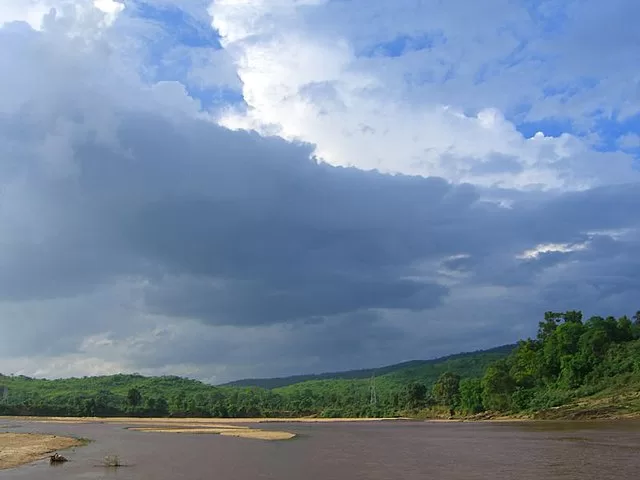
From Tribal Heritage to Statehood
Jharkhand’s history is steeped in tribal heritage and struggles for autonomy. It was carved out of Bihar in the year 2000, becoming India’s 28th state. The land has witnessed the footprints of various tribal communities, each contributing to the diverse cultural mosaic that exists today.
Enchanting Landscapes and Natural Wonders
Jharkhand is adorned with some of the most stunning waterfalls in the country. The majestic Hundru Falls cascades down from a height of about 98 meters, surrounded by lush greenery. Equally captivating is the Jonha Falls , often referred to as the Pearl of Chotanagpur for its elegance and charm.
Lush National Parks and Wildlife Sanctuaries
Nature enthusiasts will find solace in the state’s abundant national parks and wildlife sanctuaries. The Betla National Park , with its diverse flora and fauna, offers a glimpse into the untamed beauty of the region. The Dalma Wildlife Sanctua ry is another haven for wildlife lovers, providing a habitat for elephants, leopards, and various bird species.
Festivals that Illuminate the Spirit
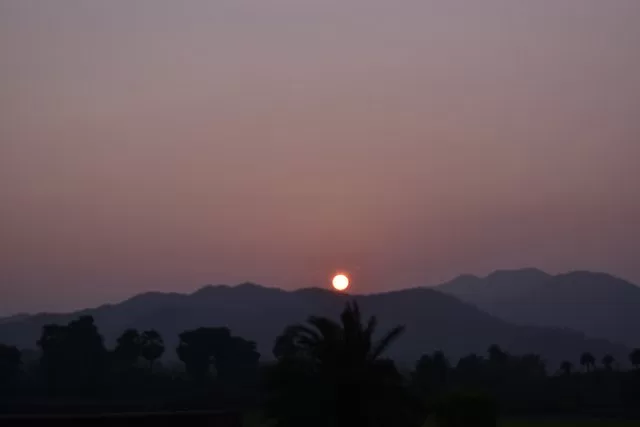
Jharkhand comes alive with vibrant festivals that reflect the spirit of its people. The Sarhul Festival , celebrated by the tribal communities, pays homage to nature and marks the beginning of the harvest season. The state also celebrates the Karma Festival , an occasion to seek blessings for a bountiful crop.
Traditional Arts and Crafts
The state’s cultural vibrancy extends to its arts and crafts. Paitkar Paintings , known for their intricate designs and vivid colors, are a unique form of tribal art that captivates art enthusiasts. The Khovar Art , which involves painting walls during weddings, showcases the artistic prowess of the locals.
Flavors that Ignite the Palate
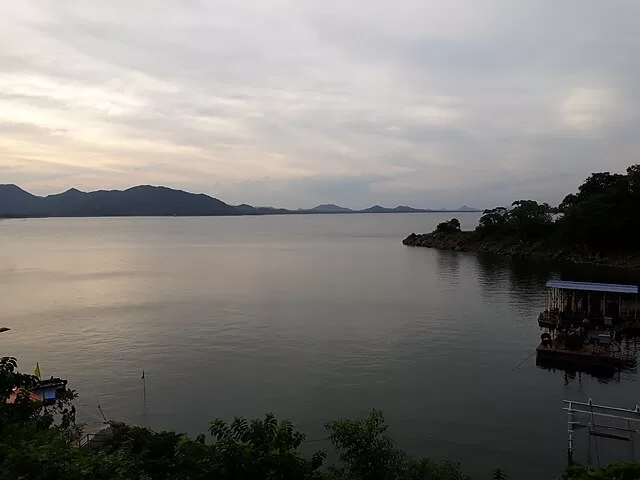
No journey is complete without savoring the local cuisine. Jharkhand’s food is a delightful blend of simplicity and taste. Thekua , a sweet snack made from wheat flour, jaggery, and coconut, is a must-try. Dhuska , a crispy rice and lentil pancake, offers a burst of flavors with every bite.
Rich Heritage in Architecture
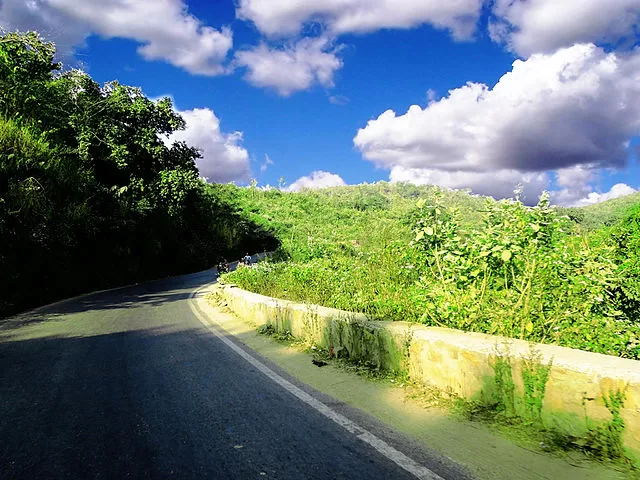
Jharkhand houses architectural wonders that reflect its historical significance. The Jagannath Temple in Ranchi is a masterpiece of architecture and spirituality, attracting devotees and tourists alike. The Hundru Rock Paintings provide a window into the prehistoric era and offer a glimpse into the evolution of human civilization.
Jharkhand, with its captivating landscapes, cultural richness, and warm hospitality, invites travelers to embark on a journey of discovery. The state’s blend of tradition and modernity, natural wonders, and cultural festivals make it a truly unique destination that should be on every traveler’s radar.
- Is Jharkhand well-connected to major cities? Jharkhand is well-connected by road, rail, and air to major cities across India, making it easily accessible for travelers.
- What is the best time to visit Jharkhand? The ideal time to visit is during the winter months, from October to March, when the weather is pleasant for exploration.
- Are there accommodations available for tourists? Yes, Jharkhand offers a range of accommodations, from budget hotels to luxury resorts, catering to various preferences.
- Are the local festivals open to tourists? Absolutely! Jharkhand’s festivals are a celebration of culture and tradition, and tourists are often welcomed to participate.
- Are English and Hindi widely spoken in Jharkhand? Yes, both English and Hindi are commonly spoken and understood in urban areas, making communication convenient for travelers.
Related Posts

Discover the Essence of Eastern India: Ranchi Unveiled
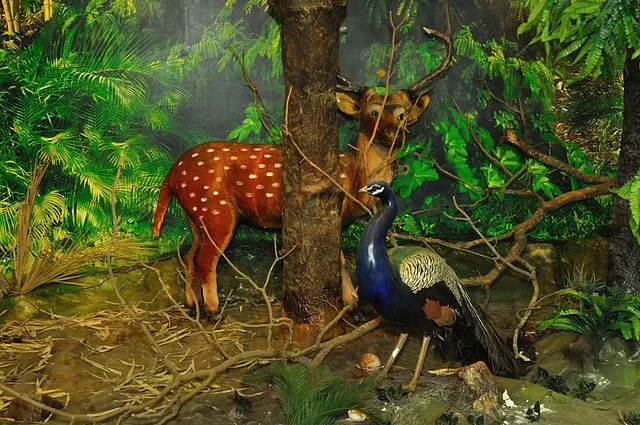
Ranchi Weather: Your Guide to Climate and Seasons
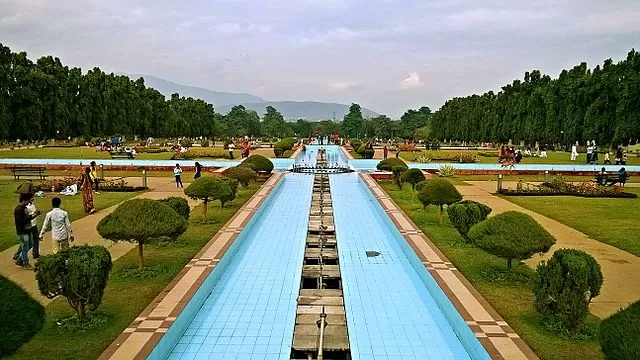
Exploring the Enigmatic Charm of Jamshedpur: A City of Dreams
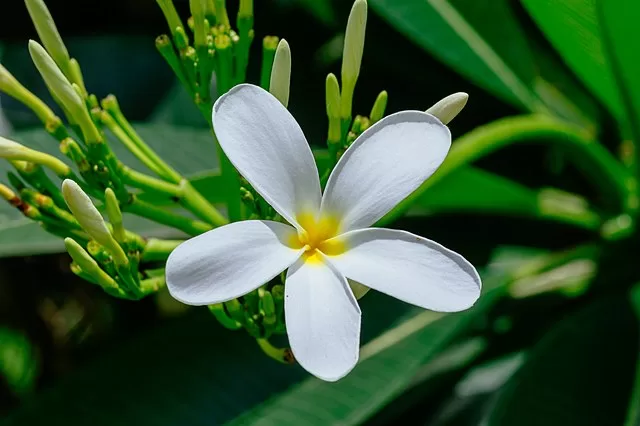
Stay Ahead: Jamshedpur Weather Forecast & Updates
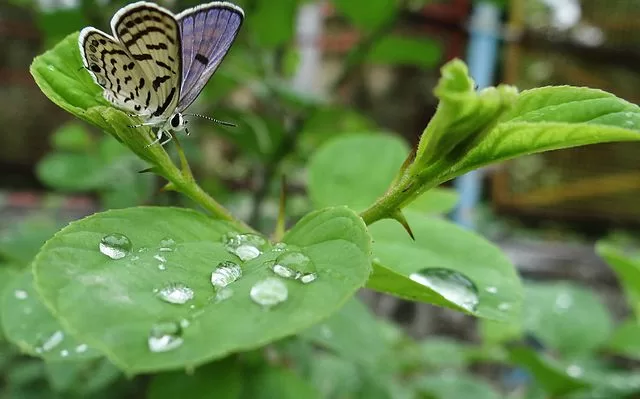

Exploring the Charms of Dhanbad: Unveiling the Hidden Treasures
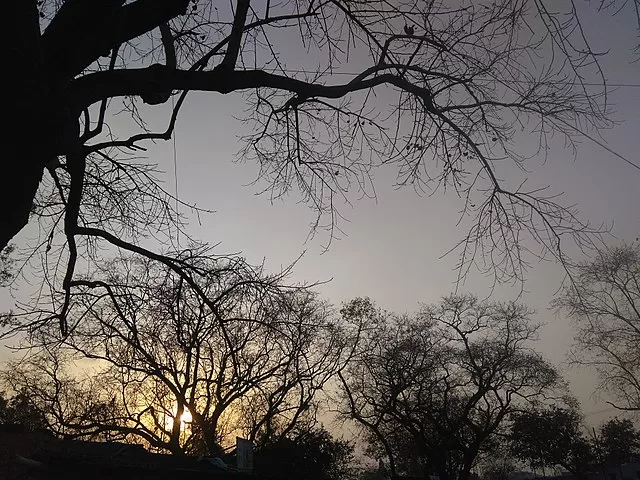
Exploring Dhanbad Weather: A Comprehensive Guide
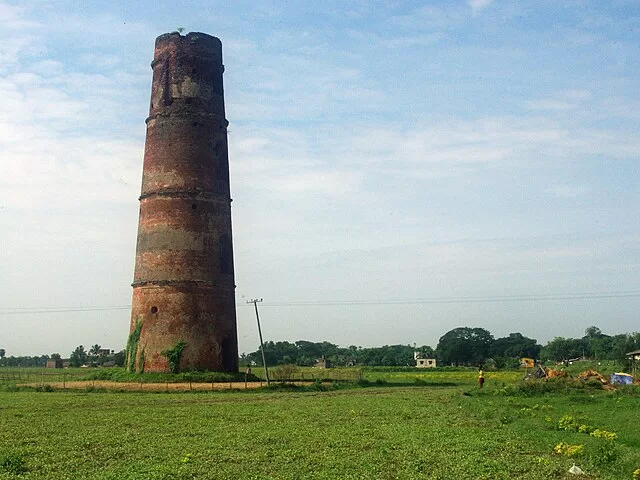
Hazaribagh: Unveiling the Hidden Gem of Jharkhand
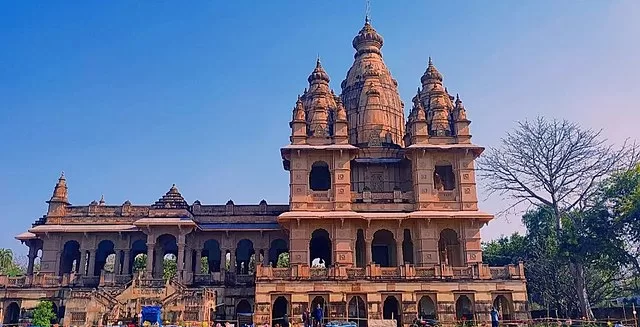
Exploring Deoghar: A Spiritual and Cultural Haven
Leave a comment cancel reply.
Your email address will not be published. Required fields are marked *
Save my name, email, and website in this browser for the next time I comment.
- Art & Culture
- Offbeat Travel
- Volunteering
- Nostalgiphilia
- Culture Directory
- Collaborate
Folk Dances of Jharkhand – True Essence of Folk Culture

- Folk Dances
- Indian Culture
Table of contents
- Chhau Dance
- Karam Dance
- Hunta Dance
- Phagua Dance
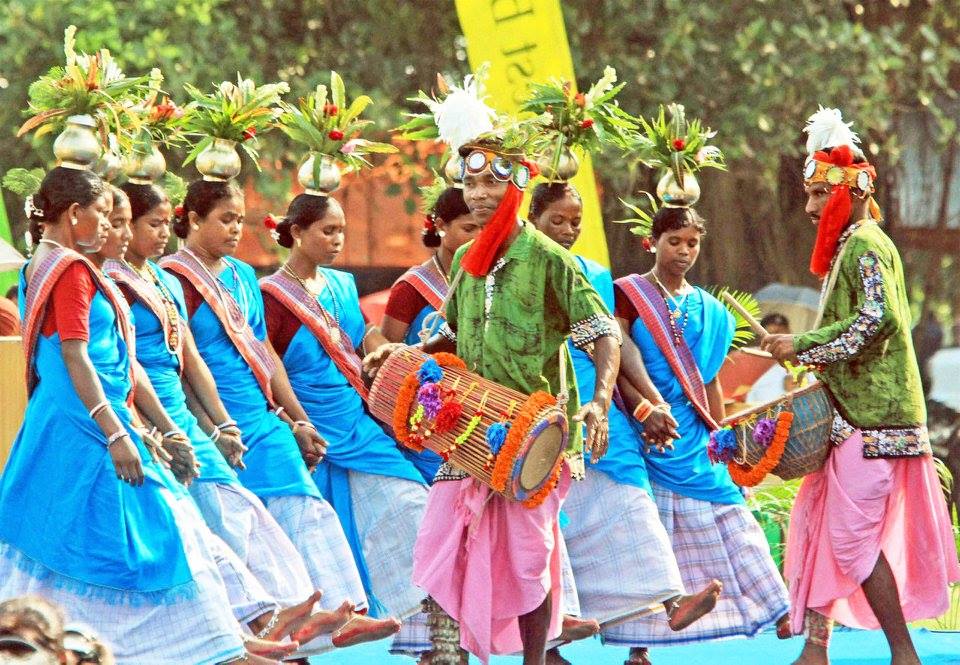
Jharkhand is a kaleidoscopic land of culture. The land is a beautiful coexistence of natural wonders along with the people who inhabit it. Culture of Jharkhand is rich with the influence of different civilizations, various ways of life, traditions, and much more. This article will discuss a particular aspect of Jharkhand’s culture, i.e., folk dances of Jharkhand. Folk dance is a primitive attribute of India, and the different states of India boast about their contribution to India’s vast arena of folk culture.
Jharkhand houses various tribal groups. The tribals’ way of living is deeply connected with nature. The folk culture of the tribals is one of the main attractions of Jharkhand. The folk songs and folk dances of Jharkhand have a unique history.
Without further ado, let us find out in detail about the various folk dances of Jharkhand. These dances have their stories and significance that make them a part of the rich folk culture of India.
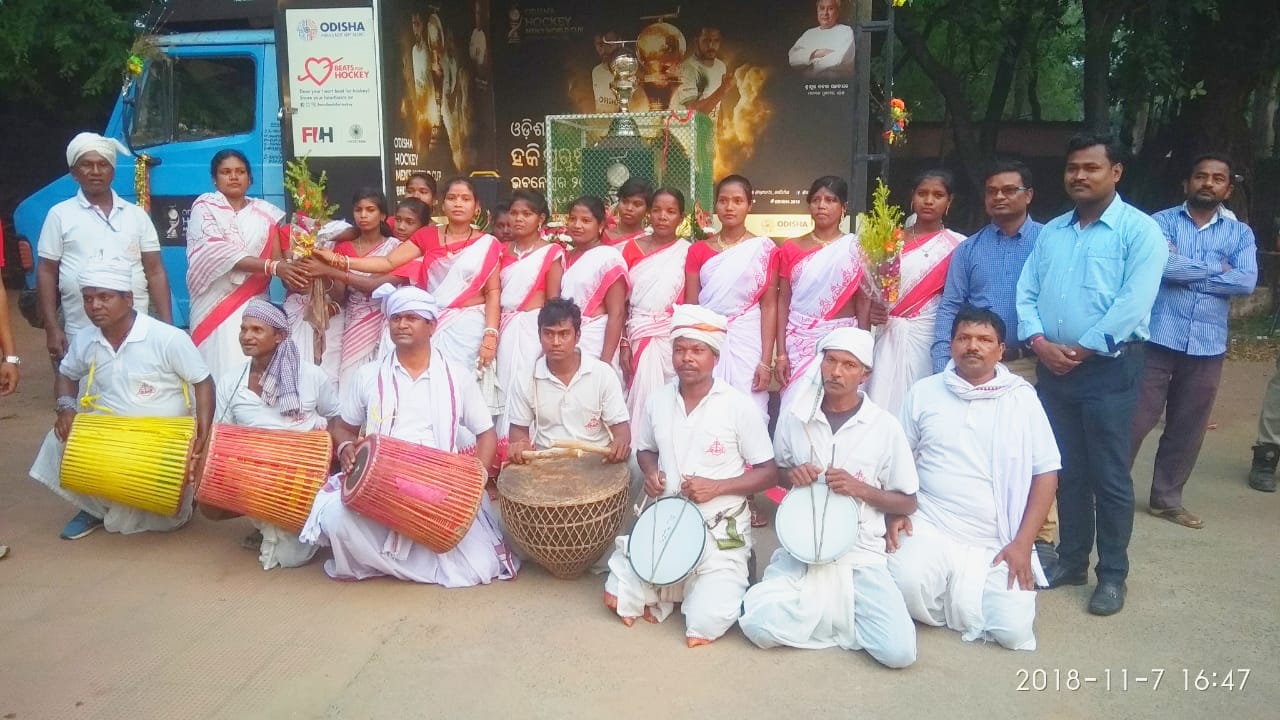
Jhumair is one of the most famous folk dances of Jharkhand. The dance is significant for its relation to the harvest season. Jhumair is a popular folk dance celebrating the happy life of the tribal folks of Jharkhand.
The dance takes place in the formation of a human chain. Men mostly dance, and the dancers themselves sing the melodious tune accompanying the dance. The dancers move along in a circular shape all the time, holding each other’s hands. Jhumair is a treat for the eye. The colorful costumes are bright and enhance the mood of the performance. Musical instruments are also a vital part of the dance. Dhol, Kartal, bansuri, and sangi provide the tune to sway along in this folk dance.
Jhumair is sometimes performed by women also. When women dance the Jhumair, the name of the folk dance changes to Janani Jhumair, another form of Jhumair is called Mardana Jhumair. This version has a touch of martial arts in its moves.
Chhau Dance
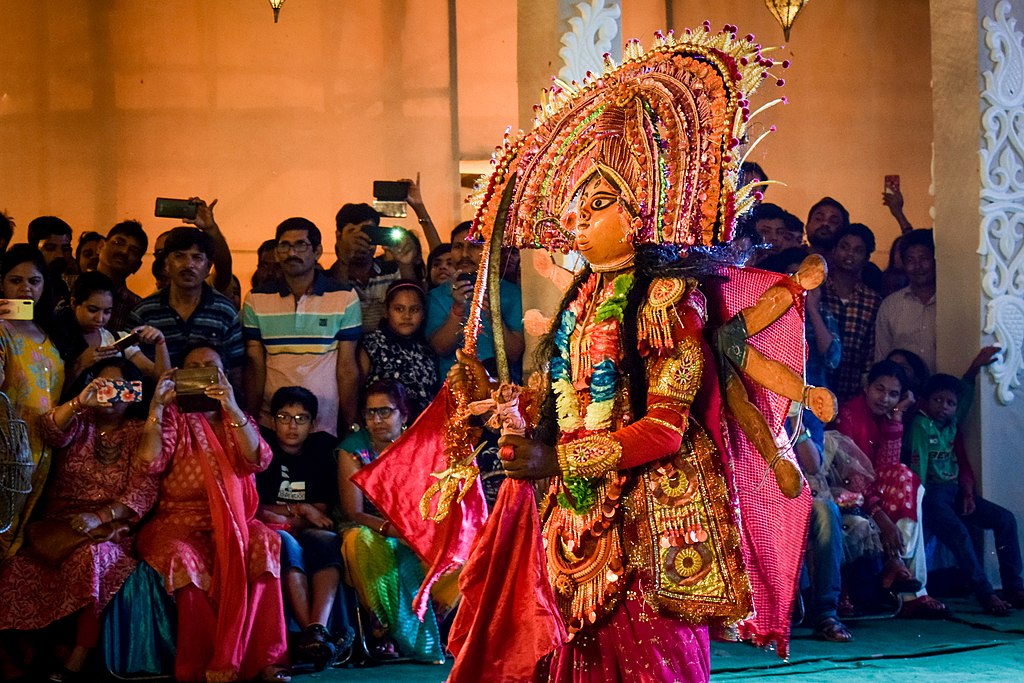
Chhau dance is one of the most famous folk dances of India . The dance is renowned for its powerful moves and distinctive mask that is a quintessential part of Chhau. Jharkhand’s neighboring states Odisha and West Bengal, are also famous for indulging in the Chhau dance.
Chhau dance takes place in an open field, primarily at night time. Etymologically Chhau comes from the Sanskrit word Chhaya which means shadow, image, shade, or mask. The main attraction of the Chhau dance is the mask that the dancers wear during the performance. The performers are both men and women who display strength through their powerful and bold dance moves. The dance dress is colorful, but the mask with its expressive, detailed work takes the spotlight. The different mask represents different characters, even figures of Gods. Chhau is also called nrithya natika, which means dance drama. The highly engaging music, rhythm, and beats accompanying the dance create a dramatic ambiance, especially with the field’s lanterns. The dance often falls in the description of to attack or hunt, adding to its dramatic effect.
Chhau is a very traditional folk dance of Jharkhand and its neighboring states. The dance is not particular to any festival but is a part of every happy occasion. Different states have specific names for Chhau dance.
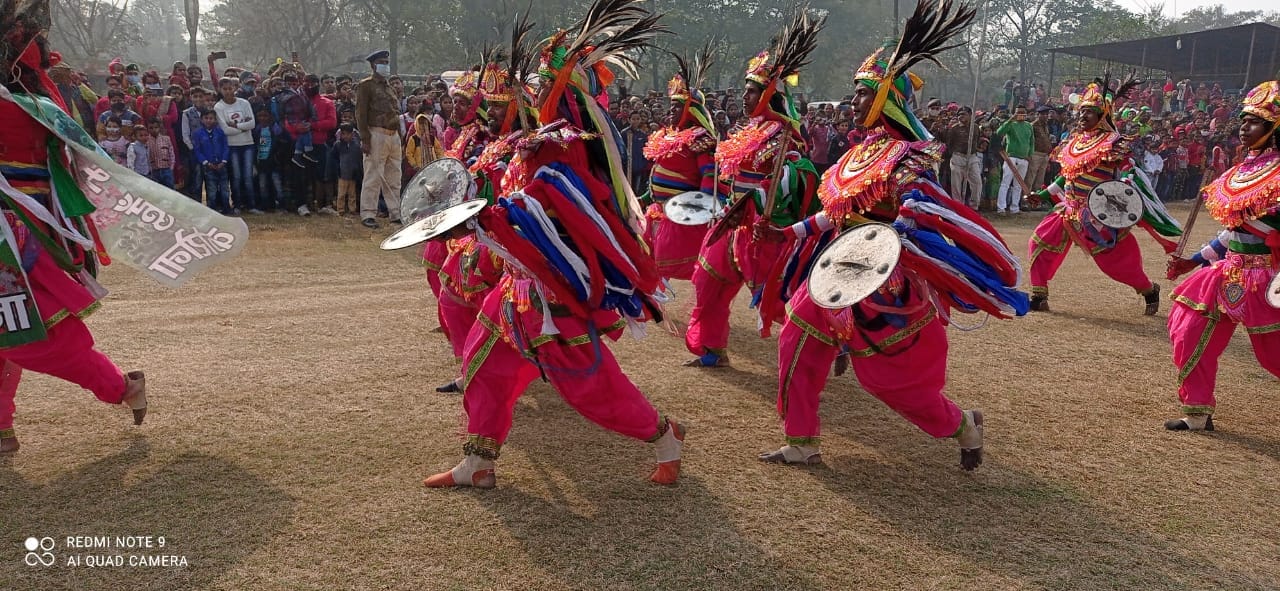
Paika is a unique dance form that is a combination of martial arts with other local dance steps. It is a dance form that requires male participation.
The dance is exciting to behold. The dance has a high degree of martial arts that involves a lot of risks. Paikas originally were a group of soldiers serving and protecting the kingdom. The Paika dance is a ceremonial dance in which physical excitement and inner courage highlight the performance. The dancers wear colorful attires with a sword in one hand and a shield in the other. Headgears and chest plates are worn as safety measures. The entire attire of the dancers and the build-up to the performance lead to the ambiance of the preparation of war. The dance steps and the martial arts are a replica of the move soldiers perform on the battlefield.
The music of this folk dance comes from the instruments of dhak, shehnai, and narsingh. The upbeat music and the bold dance moves are a joy to behold. In present days, Paika performances take place at weddings and during festive seasons. Another significant interpretation of the dance is to welcome special guests and during religious processions.
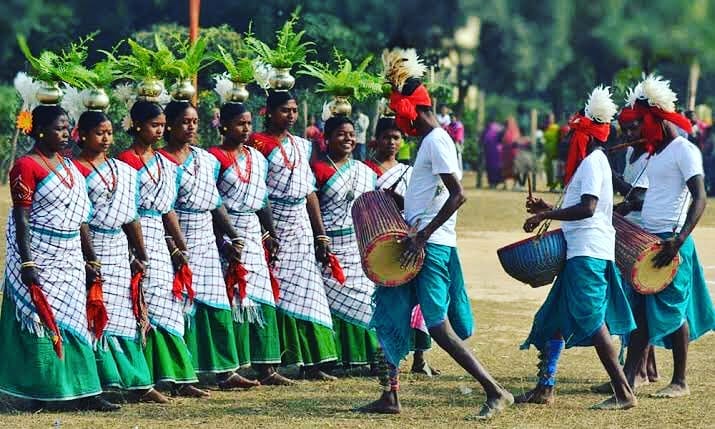
Domakch is a folk dance that is a part of the wedding rituals. Mostly the women take part in this dance while going in the baraat from the bridegroom’s house.
Domkach is an energetic and happy folk dance. The music accompanying the dance is equally enthusiastic. The women participating in the hop sing themselves. The lyrics of the song are very satirical. They crack jokes while moving around in circles. Both the women and men dress up in their colorful dresses. They all form a semi-circle while holding each other’s hand and sway along to the lively music. This wedding folk dance keeps up the high spirit of the families.
Domkach is popular in Bihar and Jharkhand. In Bihar, it is popular in Mithila and Bhojpur regions. In Jharkhand, it is also known as the Nagpuri folk dance.
Karam Dance
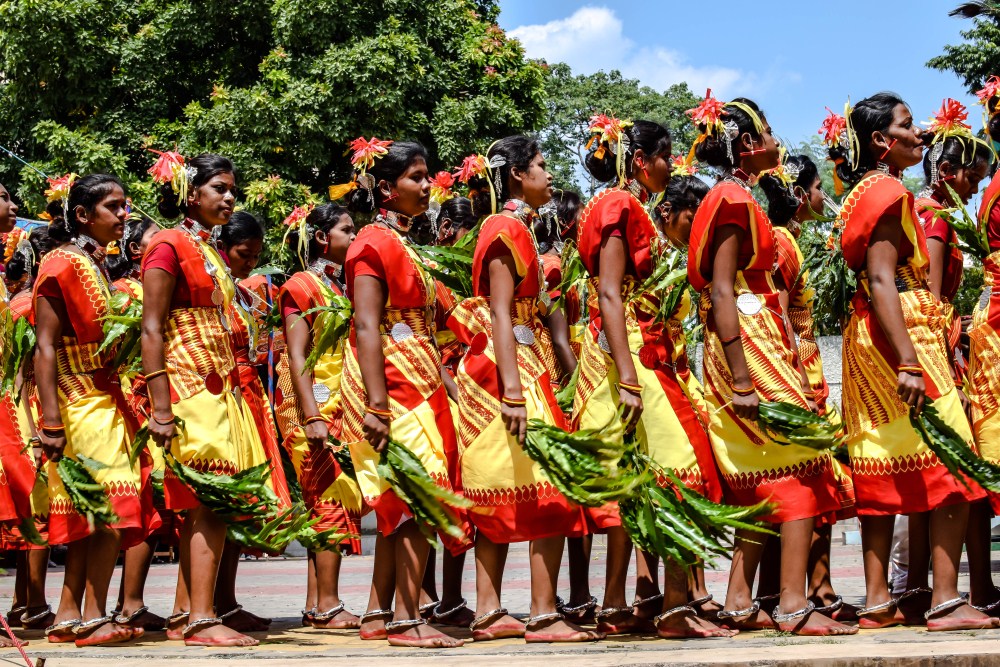
Karam dance’s name comes from the sacred tree Kadamba. People believe the Kadamba tree to be the harbinger of prosperity and good luck.
The Karam dance symbolizes the worship and planting of the Kadamba tree. The dancers, men and women, form a circle with their hands around each other’s waist. They pass a branch of the Kadamba tree while swaying to the rhythm. Once a circle passing the Kadamba branch is complete, they wash the branch with rice and milk. They believe that the branch must not touch the ground after these rituals are done. After one round, they once again start passing the branch amongst themselves.
People organize the Karam dance in August. The planting of the auspicious tree brings a lot of faith in the people.
Hunta Dance
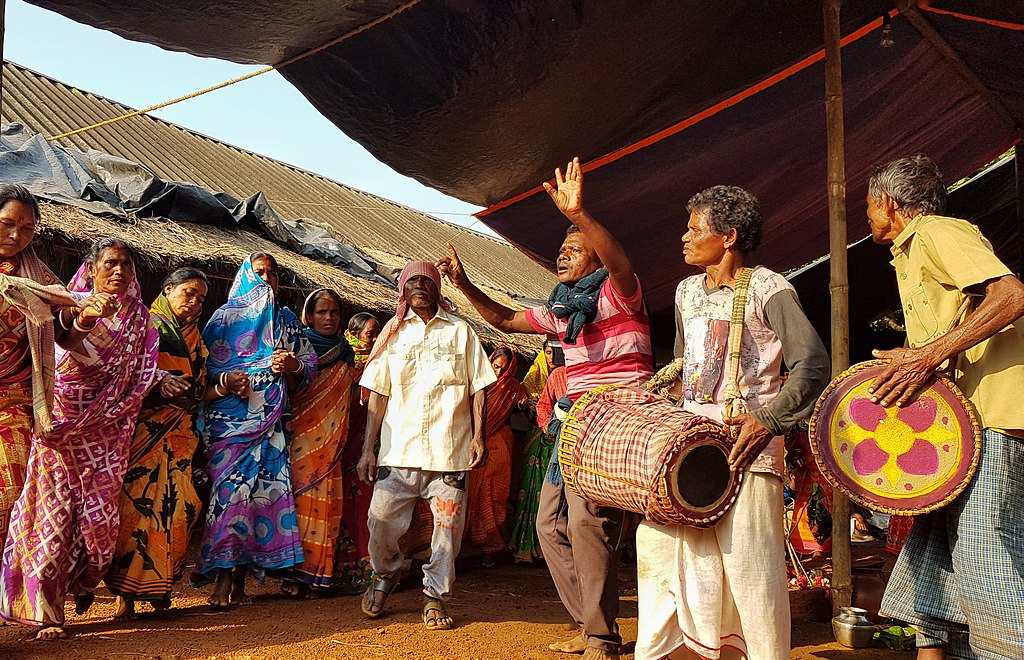
Hunta dance is the hunting dance of the Santhals of the hilly plateaus of the Chotanagpur area. The dance is a symbol of showcasing the strength, unity, and pride of the Santhals.
Both men and women participate in this dance. They attire themselves in colorful costumes, and they synchronize the color of their dresses, and their dance moves very uniquely. The men wear dhoti and turban, and the women wear their traditional saree. They all accessorize themselves with branches, leaves, and flowers. The Santhals are very close to nature, and their dresses also represent their beliefs. The Hunta dance moves depict the stance of preparing for the hunt.
The Hunta dance is a representation of the Santhals’ way of living. The dance involves mime, slow and decisive steps, and measured movements, and these features are distinctive of this ancient tribal dance.
Phagua Dance
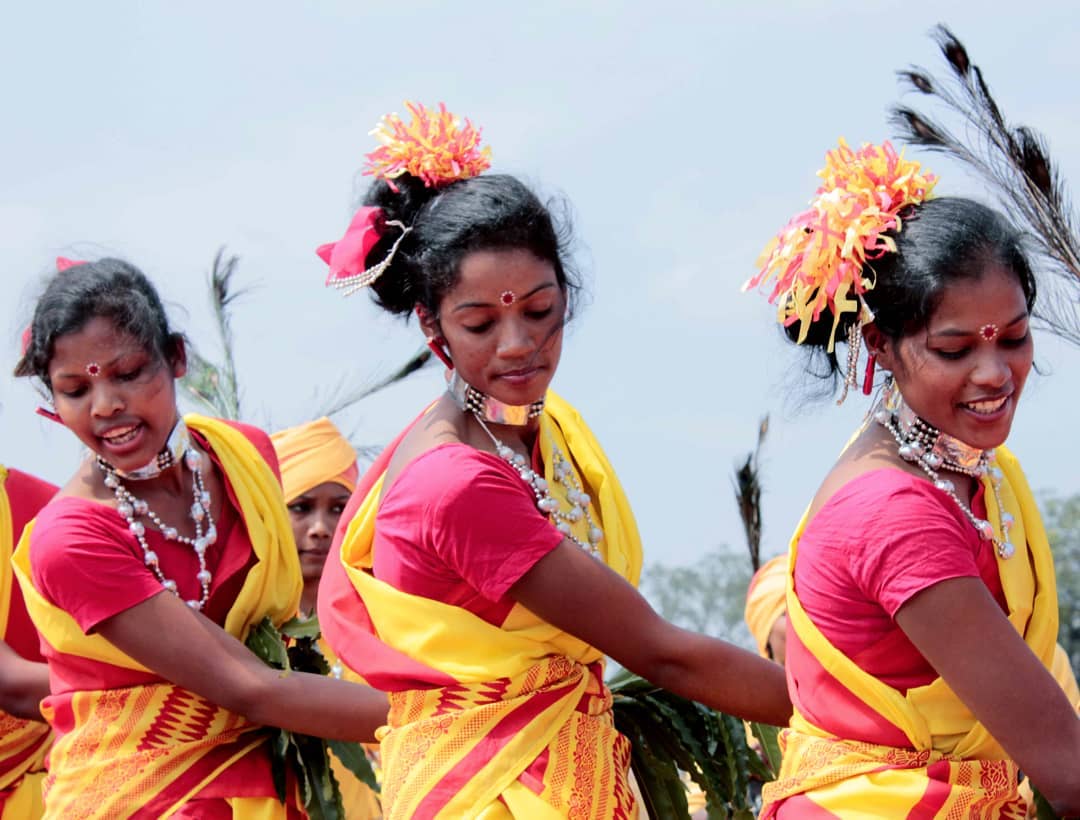
Phagua dance is another popular folk dance of Jharkhand, and the dance is an integral part of the festival of Holi.
The festival of Holi is in itself vivacious. The Phagua dance adds more enthusiasm to the colorful occasion. Only men took part in the dance earlier. In recent times, both men and women have taken part in this dance. The dancers freely move along to the lilting tune of the instruments. Mandar, dhol, and bansi are the main instruments of the Phagua dance. The dancers throw gulaal and colored water at each other.
The name of the Phagua dance comes from Falgun, the onset of Spring. The festival of Holi, along with the Phagua dance, marks the start of the festive seasons.
These folk dances of Jharkhand are also popular in its neighboring states. The tribal communities of Jharkhand try to keep the history of their culture alive with these dances. People take part in these dances enthusiastically. Visitors from across the nation and from different countries take a keen interest in these folk dances. Once you witness these dances, it is hard to stop yourself from swaying to the tunes of the instruments and joining hands with the performers.
Image credits: The copyright for the images used in this article belong to their respective owners. Best known credits are given under the image. For changing the image credit or to get the image removed from Caleidoscope, please contact us.
LEAVE A REPLY Cancel reply
Save my name, email, and website in this browser for the next time I comment.
INSPIRING READS
Venus sanghvi: artistic symphonies & cultural encounters, cultural significance of indian lullabies, odisha’s timeless tradition “danda jatra”, sita kund: the heartbeat of bihar’s cultural legacy, exploring the vibrant folk dance of telangana: a cultural journey, traditional indian summer dishes to beat the heat and be healthy, trending topics.
- Terms of Use
- Privacy Policy
Affiliate disclosure: As an Amazon Associate, we may earn commissions from qualifying purchases from Amazon. Learn more
© caleidoscope - 2024.
Jharkhand PCS Exam Notes
One Point Solution for JPSC Preparation
Cultural Art Of Jharkhand

Folk Paintings or Paitkar or SCROLL PAINTING
These are one of the oldest tribal paintings in India and due to their appearance they are also called scroll paintings. Artisans from the Paitkar community use natural colour and vermillion to paint on soiled or used papers. The hair of a goat or the help of a needle is taken to apply the colour. The essence of these paintings is found in the Garuda Purana. Rapidly extincting community of folk painters of the state known as ?Paitkar‘ make scroll painting. Mainly they illustrate the primitive concept of “life after death”.
Jadopatia Paintings
These are generally practised by the Santhals in which the artisans make scrolls called Jado or Jadopatia and are drawn with natural inks and colours. They are used as visual aids in storytelling and are said to have magical and healing powers. They depict scenes of afterlife and the Santhal belief of tiger God etc.
This is generally practiced by the women of farming communities and is a rural art form called Sohrai. They are mural paintings depicting the harvest festival in autumn and are considered to bring good luck. They are painted with red, black, white and yellow earth and large images are painted on the walls with twigs and thin sticks depicting pictures of animals like bulls, horses, wild animals and horned deities.
This is also practised by the women of the farming community depicting the marriage season. They are generally carried out in the walls of the bridal chamber and the walls of the wedding house. Designs are cut with fingers exposing black patterns on white or with bits of combs. Over an undercoat of black earth a layer of wet Dudhi mitti or cream coloured earth is painted. This technique of comb cutting is similar to the‘ Sgraffito‘ technique of Greece and the incised pottery technique found in Iran and the Indus valley. These paintings are considered to bring good luck.
It is a metal craft or brass work done by the Malhore caste and the artisans make use of the ? lost wax technique‘ by using resin, wax and firewood from the forests and clay from the riverbed and with the help of a firing oven in a hole dug in the ground they craft their artwork.
This art is drawn in large murals with images of plants, birds and animals and sometimes endangered animals are depicted in the pictures in story tradition form.
Rana, Teli and Prajapati Art
This art is practised by the three sub castes using filigree work with plant and animal fertility forms using Pashupathi (Lord Shiva) representing the God of Animals and colourful floral motifs.
Lord Shiva or Pashupathi on the back of a bull is the horned deity depicted here and glyptic art is used to represent plants on the floors and walls of the Kurmi tribe. A wooden compass is used to etch the segmented lotus and drawings are scratched on the walls with nails.
Plant forms of deities and unique motifs like the rainbow snake are painted on the wet, soft earth using fingers and the mud collected from rock art sites is lavender gray along with ochre mud.
Natural earthy colours of floral and jungle based motifs are painted on the walls of the homes.
Birhor and Bhuiya Art
These depict mandalas or authentic graphic forms with stars, crescents, rectangles, concentric circles etc drawn with fingers.
Ghatwal art
They depict paintings of animals along with their dwellings in the forest.
The mask made of Papier machei in Singhbhum has its own significance. Paper machei of Kashmir is famous for house wares and decorative items with delicate painting and papier machei of Madras is well known for large size sculpted images. The papier machei of Saraikela and Charinda is popular for the mask for Chhou Dance. The methods and materials are separate from each other.
WOODEN WORK
BAMBOO WORKS
The bamboo found in this thick forest is of a special quality. These bamboos are thin but strong and flexible. The artisan of Jharkhand use these bamboos in different artifacts like, basket, hauting & fishing equipments. Besides the Mahlis, Kharia‘s in some villages have taken this trade for their survival. Particularly, the fishing cage made by the Kharias are excellent.
Broken pieces of potteries are found in the bank of Subernarekha in Dulmi are of good quality with design and painting on it, reveals its trend.
The community surviving in jungle by fishing and hunting has a high quality of weaving skill, eg. dress materials and nets for hunting and fishing are very intricate with fascinating patterns. Still these weavers, called Tanti, make typically designed dress for Santhal.
Tribals are very fond of ornaments all over the world. So the tribal of this area inherently use various types of ornaments; like the ornaments made of bead, precious stones metals like gold and silver. Design is very simple like their art. Moal a rounded pipe of silver on feed, flats waste girt, spiral silver wires on wrist and arm, wide
variety of necklace, ear ring etc
In the area weapon art is not much conventional but very common and similar to the primitive people. The black smiths produce all required tools and weapons for griculture and safety.
RITUALLISTIC OFFERINGS
The people of this area are totemic so they use several ritualistic offerings like clay made horse, elephants etc. to pacity their village gods and goddesses.
STONE CARVING
Even a few years back the tradition of stone carving was alive. Some families who were well skilled are not showing up any more, only few artisans are seen in the state.
Besides agricultural implements, hunting tools and weapons are the product by the blacksmith. The Malhar and Thentri communities are expertise in metal casting, mainly producing house wares. Malhar are nomadic but the Thentris are settle amidst the tribes in the state.
Other specific folk art forms are as follows:-
body painting (tatoo),
stone cutting,
bull painting (during Bandna)
folk painting fresco,
sculpting horse, elephant etc. are used for the ritual purpose.
Also they used to craft some totemic images in the wood.
Decoration of wall is very common art.
The methods and materials used are traditional and handed down in the families, gene ration after generation and still persist with little alteration. It is unsophisticated of even rough hewn, often with bold colours. The quality of freshness, spontaneity, sincerity and simplicity of their art are appreciable. The type of decorative designs has characteristic of new Stone Age or Neolithic. It is quite clear through study of primitive art that there are some principles of form and decoration which are universal. The patterns become very schematic and are more geometrical.
- JPSC Mains Tests and Notes Program
- JPSC Prelims Exam 2020- Test Series and Notes Program
- JPSC Prelims and Mains Tests Series and Notes Program
- JPSC Detailed Complete Prelims Notes
Leave a Comment Cancel reply
You must be logged in to post a comment.
- LIVE DISCOURSE
- BLOG / OPINION
- SUBMIT PRESS RELEASE
- Advertisement
- Knowledge Partnership
- Media Partnership
BJP, JMM Candidates Submit Nominations for June 1 Parliamentary Polls in Jharkhand
Three bjp and two jmm candidates filed nominations for lok sabha elections in dumka, godda, and rajmahal. bjp's sita soren, nishikant dubey, and tala marandi, and jmm's nalin soren and vijay hansdak submitted their papers. dubey predicted a record victory in godda, while soren pledged to focus on water supply and job creation in dumka if elected..

Three BJP candidates — Sita Soren, Nishikant Dubey and Tala Marandi — and two JMM nominees —Nalin Soren and Vijay Hansdak — on Friday filed their nomination papers for the upcoming Lok Sabha polls scheduled on June 1.
Sita Soren, sister-in-law of the imprisoned former chief minister Hemant Soren, submitted her papers for Dumka Lok Sabha seat, Dubey (Godda) and Tala Marandi (Rajmahal).
All three BJP candidates exuded confidence of winning the polls. ''This time, I will win the Godda seat with a record margin,'' Dubey claimed.
Attacking the Congress, Dubey said, ''Congress does vote bank politics while Modi banks on 'Sabka Saath, Sabka Vikas'.'' Meanwhile, JMM legislator from Shikaripara assembly constituency, Nalin Soren, filed his nomination for Dumka Lok Sabha seat, while sitting MP Vijay Hansdak submitted his papers for Rajmahal.
''If I win, my focus will be ensuring 365 days of pure drinking water for the people of the constituency, irrigation facility for farmers and jobs for unemployed youth,'' he said.
Rajmahal, Dumka and Godda Lok Sabha seats will go to polls on June 1.

Reuters Health News Summary

Apple's New Jersey store workers vote against unionizing, Bloomberg reports

Adani Enterprises Plans Massive Investment of Rs 80,000 Crores in Current Fi...

Alarming Increase in Dog Bite Incidents Concerns Itanagar and Naharlagun
Latest news, spain's socialists hail 'new era' in catalonia as separatist support dims in elections, north korea denounces western states for surveillance under un sanctions guise, kcna says, blinken warns israel over gaza conduct, calls for de-escalation, israel pushes back into northern gaza, ups military pressure on rafah.

OPINION / BLOG / INTERVIEW
Green metropolises: navigating the path to sustainable urban growth globally, the creative frontier: unleashing potential with generative ai, customized minds: the ai revolution in learning and behavioral change, transformative strategies for high-density cities, connect us on.
- ADVERTISEMENT
- KNOWLEDGE PARTNERSHIP
- MEDIA PARTNERSHIP
- Agro-Forestry
- Art & Culture
- Economy & Business
- Energy & Extractives
- Law & Governance
- Science & Environment
- Social & Gender
- Urban Development
- East and South East Asia
- Europe and Central Asia
- Central Africa
- East Africa
- Southern Africa
- West Africa
- Middle East and North Africa
- North America
- Latin America and Caribbean
OTHER LINKS
- Write for us
- Submit Press Release
- Opinion / Blog / Analysis
- Business News
- Entertainment News
- Technology News
- Law-order News
- Lifestyle News
- National News
- International News
OTHER PRODUCTS
Email: [email protected] Phone: +91-720-6444012, +91-7027739813, 14, 15
© Copyright 2024
The Significance of the Color Black in Fashion and Cultural Identity
This essay about the color black in fashion explores its significance as a timeless and versatile symbol. It highlights black’s role in expressing elegance, rebellion, cultural identity, and psychological empowerment. The discussion ranges from historical uses in subcultures to its impact on modern fashion diversity and inclusivity efforts. Black’s unique qualities make it a staple in fashion, symbolizing both authority and individual empowerment, and it continues to inspire and influence across generations.
How it works
In the diverse world of fashion, the color black stands out as a powerful symbol, transcending temporal and stylistic boundaries. Its depth goes beyond mere aesthetics, touching upon cultural symbolism and psychological influences. An exploration into the essence of black unveils a complex narrative that intertwines historical, fashion-related, and psychological threads.
In fashion circles, black is celebrated as the ultimate marker of elegance and adaptability. Its charm derives from its dual capacity to embody both simplicity and sophistication. Coco Chanel aptly captured this sentiment, stating, “Black has it all.
White too. Their beauty is absolute. It is the perfect harmony.” Black is unique in its ability to integrate into any setting while maintaining a distinct presence through its subtle grandeur. From the timeless little black dress to the crisp silhouette of a bespoke black suit, black stands as a perennial icon of style, enduring through changing trends.
However, black’s significance stretches further into cultural realms, symbolizing rebellion, empowerment, and identity. Historically, black attire has been the choice of various subcultures as an emblem of protest and individualism. From the artistic beatniks of the 1950s to the defiant punk movements of the 1970s, black clothing has served as the garb of resistance, a visual challenge to mainstream norms and values.
Additionally, black holds deep symbolic meaning across various cultures. In Western contexts, it is often linked to mourning and solemn ceremonies, representing grief and respect. Yet, it also connotes authority and formality, as seen in the traditional black robes of judges and religious figures. The mysterious and intriguing aspects of black further enhance its cultural resonance, sparking the imagination.
For African and African-American communities, black bears particular significance, symbolizing the beauty of melanin and the strength of marginalized groups. Black garments, often embellished with vivid patterns and motifs, celebrate cultural heritage and affirm a collective identity and pride.
The impact of black extends into the fashion industry’s efforts towards inclusivity and diversity. The “Black is Beautiful” movement of the 1960s heralded a celebration of African-American beauty, challenging the prevailing Eurocentric beauty norms. Since then, black designers and models have been pivotal in introducing greater diversity into fashion, transforming industry standards.
Psychologically, the allure of black is profound, often associated with feelings of confidence and authority. The “black effect” is a phenomenon where donning black clothing can enhance one’s sense of empowerment and self-assurance. Whether through the sleek appearance of a black outfit or the comfort of a favorite black piece, the color wields a transformative power, enhancing the wearer’s confidence.
To summarize, black’s role in fashion and cultural expression is deep and layered. From its enduring elegance to its representation of cultural and individual identity, and its psychological impact, black embodies a symbol of autonomy, resistance, and empowerment. As fashion and societal norms evolve, black remains a constant, inspiring and empowering future generations.
Cite this page
The Significance of the Color Black in Fashion and Cultural Identity. (2024, May 12). Retrieved from https://papersowl.com/examples/the-significance-of-the-color-black-in-fashion-and-cultural-identity/
"The Significance of the Color Black in Fashion and Cultural Identity." PapersOwl.com , 12 May 2024, https://papersowl.com/examples/the-significance-of-the-color-black-in-fashion-and-cultural-identity/
PapersOwl.com. (2024). The Significance of the Color Black in Fashion and Cultural Identity . [Online]. Available at: https://papersowl.com/examples/the-significance-of-the-color-black-in-fashion-and-cultural-identity/ [Accessed: 12 May. 2024]
"The Significance of the Color Black in Fashion and Cultural Identity." PapersOwl.com, May 12, 2024. Accessed May 12, 2024. https://papersowl.com/examples/the-significance-of-the-color-black-in-fashion-and-cultural-identity/
"The Significance of the Color Black in Fashion and Cultural Identity," PapersOwl.com , 12-May-2024. [Online]. Available: https://papersowl.com/examples/the-significance-of-the-color-black-in-fashion-and-cultural-identity/. [Accessed: 12-May-2024]
PapersOwl.com. (2024). The Significance of the Color Black in Fashion and Cultural Identity . [Online]. Available at: https://papersowl.com/examples/the-significance-of-the-color-black-in-fashion-and-cultural-identity/ [Accessed: 12-May-2024]
Don't let plagiarism ruin your grade
Hire a writer to get a unique paper crafted to your needs.

Our writers will help you fix any mistakes and get an A+!
Please check your inbox.
You can order an original essay written according to your instructions.
Trusted by over 1 million students worldwide
1. Tell Us Your Requirements
2. Pick your perfect writer
3. Get Your Paper and Pay
Hi! I'm Amy, your personal assistant!
Don't know where to start? Give me your paper requirements and I connect you to an academic expert.
short deadlines
100% Plagiarism-Free
Certified writers
- Manage Account
This Is the Best Start to a Year We’ve Had in Pop This Decade (Essay)
By, like, a lot .
By Andrew Unterberger
Andrew Unterberger
- Share this article on Facebook
- Share this article on Twitter
- Share this article on Flipboard
- Share this article on Pinit
- + additional share options added
- Share this article on Reddit
- Share this article on Linkedin
- Share this article on Whatsapp
- Share this article on Email
- Print this article
- Share this article on Comment
- Share this article on Tumblr
![essay on culture of jharkhand Taylor Swift performs with Sabrina Carpenter at Accor Stadium on Feb. 23, 2024 in Sydney, Australia.Swift performs with Sabrina Carpenter at Accor Stadium on February 23, 2024 in Sydney, Australia. (Photo by Don Arnold/TAS24/[SOURCE] for TAS Rights Management)](https://www.billboard.com/wp-content/uploads/2024/02/taylor-swift-sabrina-carpenter-sydney-2024-billboard-1548.jpg?w=942&h=623&crop=1)
Around this time two years ago at Billboard , we were all asking: Where are the new hits ?
Through the first few months of 2022, the Billboard Hot 100 was stocked almost exclusively with holdovers from 2021 and even 2020 or earlier, with totally new music in precious short supply in the chart’s top tiers. Relief eventually came that month in the form of Harry Styles’ instant runaway smash “As It Was,” and then as April turned to May, via new albums by Future, Bad Bunny and Kendrick Lamar. But it still felt like the year was playing catch-up, like at midyear 2022 was still only just properly getting started.
J. Cole or Drake: Who Needs to Respond More to Kendrick Lamar's Verse? The Cases for Both
See latest videos, charts and news
Trending on Billboard
Let’s start with the list of A-list artists who have already released entirely new albums by May 9: Beyoncé, Taylor Swift, Ariana Grande, Ye & Ty Dolla $ign, Future & Metro Boomin (twice!), J. Cole and Dua Lipa. (Depending on your “A-list” definition, you could also potentially throw Usher, Justin Timberlake and Kacey Musgraves on that list as well.) Hell, you could probably cut the list after the second name and the point would still stand: Any year where you get new sets by Beyoncé ( Cowboy Carter ) and Taylor Swift ( The Tortured Poets Department ) — the two most celebrated pop stars in the world right now — before Memorial Day, you’re probably off to a pretty fast start. And both sets have been enormous, world-building, culture-conquering affairs, with huge Hot 100-topping lead singles and no shortage of critical and fan discourse over their deeper implications.
Speaking of “Like That”: That Kendrick Lamar-assisted chart-topper essentially knocked the hip-hop world off its usual axis, kicking off the back-and-forth with Drake that has somehow managed to overshadow everything else that’s gone on in popular music so far this year. J. Cole responded first to Lamar’s pot-stirring “Like That” verse, on his lukewarmly received Might Delete Later mixtape and its closing “7 Minute Drill,” before publicly bowing out of the beef and deleting “Drill” from streaming services. But Drake was determined to get his money’s worth: He responded with both the leaked “Push Ups” and the social media-released “Taylor Made Freestyle” — which featured unlicensed, AI-generated guest verses “from” West Coast legends Snoop Dogg and the late Tupac Shakur, and was eventually taken down upon threat of legal action from the Shakur estate.
The Kendrick-Drake feud has been the biggest in music this year, but it wasn’t the first. The stage was set for that blockbuster beef by the January back-and-forth between Megan Thee Stallion, whose “Hiss” was thought to have subliminals aimed at rap rival Nicki Minaj (as well as additional lyrics assumed to be shots at Drake and other rap-world figures), and which inspired a response track (in addition to a lot of social media talk) from Minaj in the form of “Big Foot.” The fallout from that beef was mostly contained to the release week of the two tracks, but it helped Megan secure her first-ever entirely solo Hot 100 No. 1 for “Hiss,” and generally established the competitive tone for hip-hop among its biggest 2024 artists.
But the real reason 2024 has been so exciting, even beyond all these recognizable names showing up and showing out, is the equally impressive list of rising stars who have made their mark on the year so far.
Música Mexicana phenom Xavi began the year with two songs already climbing the top 100, and plenty more seemingly to come. Teddy Swims and Benson Boone have forced top 40 to make room for big soulful vocals and even bigger screaming guitar, with their crossover smashes “Lose Control” and “Beautiful Things,” respectively. Alt-rock has seen its fortunes revived on the chart through Djo’s psych-leaning “End of Beginning” and Artemas’ darkwave-inspired “I Like It When You Kiss Me,” both surprise top 20 Hot 100 hits. Even longtime cult favorite Hozier, a decade removed from his breakout hit “Take Me to Church,” is now back with a somehow-even-bigger hit: “Too Sweet,” lifted to No. 1 by good TikTok buzz and the currently rising tides of alt-folk and soul-pop.
For a few of these breakout artists, the success has been a long time coming. Sexyy Redd built up momentum for most of 2023 with viral hits “Pound Town” and “SkeeYee” — culminating in a feature appearance on Drake’s For All the Dogs No. 11 hit “Rich Baby Daddy” — but she’s taken it to a new level this year with her first solo top 20 hit, the dancefloor shout-along “Get It Sexyy.” Glorilla has taken a similar path to solo success with her own self-referencing smash “Yeah Glo!,” while also joining forces with Megan Thee Stallion for the chart-storming “Wanna Be.” Sabrina Carpenter and Chappell Roan were pop favorites with critical acclaim disproportionate to their actual top 40 presence — but following opening slots on Taylor Swift’s and Olivia Rodrigo’s recent tours, they’ve both seen raised profiles and higher levels of crossover stardom with new singles “Espresso,” and “Good Luck Babe!,” respectively, both all but sure to keep growing into the warm-weather months.
The sheer volume of impressive hits so far this year can be seen in the amount of turnover on the Hot 100 — particularly in the top spot, where no one song has reigned for more than three consecutive weeks (“Like That,” again). We’ve already seen 11 different songs top the Hot 100 across the first 19 chart weeks, compared to seven last year and just six in 2022. Both of those years saw a No. 1 hit reign for 15+ weeks seemingly almost by default: “As It Was” and Morgan Wallen’s “Last Night” didn’t dominate because they kept finding new ways to infiltrate pop culture (a la Lil Nas X with “Old Town Road” ), but simply because the competition usually just wasn’t strong enough across the board to consistently threaten their supremacy. This year, with everything that’s been happening, it seems unlikely that either song would even get to double-digit weeks on top.
Regardless of the reasons, it’s been a transfixing start to the year in popular music, with major contributions seemingly coming from all different corners of the music world, and from all different levels of artists. And what’s more, it doesn’t look to be slowing down anytime soon: This Friday brings with it a new album from Gunna and a new single from Post Malone and Morgan Wallen, the latter being arguably the biggest remaining recording artist in contemporary music who we haven’t heard much new from this year. And then the week after, it’s time for Billie Eilish’s much-hyped Hit Me Hard and Soft album, her first full-length set to arrive with no advance singles. Get your rest days in where you can and maybe hope for a bit of a summer vacation in a couple months, because it doesn’t look like pop is going to be taking it easy on us anytime in the near future — we’re exhausted, but elated.
Get weekly rundowns straight to your inbox
Want to know what everyone in the music business is talking about?
Get in the know on.
Billboard is a part of Penske Media Corporation. © 2024 Billboard Media, LLC. All Rights Reserved.
optional screen reader
Charts expand charts menu.
- Billboard Hot 100™
- Billboard 200™
- Hits Of The World™
- TikTok Billboard Top 50
- Song Breaker
- Year-End Charts
- Decade-End Charts
Music Expand music menu
- R&B/Hip-Hop
Videos Expand videos menu
Culture expand culture menu, media expand media menu, business expand business menu.
- Business News
- Record Labels
- View All Pro
Pro Tools Expand pro-tools menu
- Songwriters & Producers
- Artist Index
- Royalty Calculator
- Market Watch
- Industry Events Calendar
Billboard Español Expand billboard-espanol menu
- Cultura y Entretenimiento
Get Up Anthems by Tres Expand get-up-anthems-by-tres menu
Honda music expand honda-music menu.

Roger Corman: a career in pictures
- Share on Facebook
- Share on Twitter
- Share via Email
Best known for his low-budget Edgar Allan Poe adaptations, Corman also produced over 400 films and helped kickstart the careers of Jack Nicholson, Nicholas Roeg, Peter Fonda, James Cameron and Martin Scorsese
- News: Corman dies aged 98
- Peter Bradshaw’s appreciation
- Roger Corman obituary
Greg Whitmore
Sun 12 May 2024 08.59 BST Last modified on Sun 12 May 2024 22.07 BST
Photograph: Hulton Archive/Getty Images

Day The World Ended, 1955
Photograph: Alamy

The Undead, 1957
Photograph: The Kobal Collection

Not Of This Earth and Attack Of The Crab Monsters, both 1957
Composite: Movie Poster Image Art/ Getty Images

Attack of the Crab Monsters, 1957

Teenage Doll, 1957
Photograph: Everett/REX Shutterstock

The Wasp Woman, 1959
Photograph: Moviestore/REX Shutterstock

The Fall of the House of Usher, 1960

The Little Shop of Horrors, 1960

The Pit and the Pendulum, 1961

X: The Man with the X-Ray Eyes, 1963
Photograph: Public Domain

Tomb of Ligeia, 1964

The Masque of the Red Death, 1964
Composite: BFI

The Wild Angels, 1966

Photograph: Ronald Grant Archive

The St. Valentine’s Day Massacre, 1967
Composite: REX Shutterstock/Alamy

The Trip, 1967
Photograph: Movie Poster Image Art/Getty Images

Bloody Mama, 1970
Composite: REX/Ronald Grant Archive

Photograph: Getty Images

Frankenstein Unbound, 1990
Composite: REX Shutterstock

Photograph: Michael Yada/Getty Images

Photograph: Victoria Will/Invision/AP

- Roger Corman
- Horror films
- Science fiction and fantasy films
- Edgar Allan Poe
More galleries
View all comments >.
- recommendations
Most popular

IMAGES
VIDEO
COMMENTS
Karam is a major native harvest festival of Jharkhand. It is celebrated on the 11th day of a full moon of the month of Bhado by the Sadan (Khortha, Nagpuri, Kurmali-speaking ethnic group) and the tribal (Munda, Bhumij, and Oraon) people of Jharkhand. During this festival, people bring branches of the Karam tree to the village and then place them on the ground.
Jharkhand is an eastern state of India, which was carved from the southern part of Bihar on 15th November 2000 after a long and protracted demand for a separate State.Jharkhand borders state of Bihar in the north, Uttar Pradesh and Chhattisgarh in the west, Odisha in the south and West Bengal in the east.. Jharkhand is the fourteen largest state in terms of population and the 15th largest ...
Jharkhand Culture: Overview. The cultural tapestry of Jharkhand, envisioned and refined by generations of diverse communities dwelling in the region since time immemorial, bears the imprints of legendary groups such as the Asurs, Santhals, Banjara, Bihor, Chero, Gond, Ho, Khond, Lohra, Mai Pahariya, Munda, Oraon, Kol, and Kawar—comprising over thirty-two tribal entities, constituting 28% of ...
The culture of the people of Jharkhand depends upon the community to which they belong to and accordingly it is influenced on their life style, festivals, rituals, music, language and literature. The largest tribal settlement of Jharkhand is the Santhal tribal community where they are concentrated in areas like Dumka, Godda, Deoghar, Jamtara ...
The short essay on Jharkhand explores its rich tribal culture, economic significance in minerals, and the delicate balance between tradition and modernization in eastern India. Jharkhand, nestled in eastern India, is a cultural kaleidoscope with a prominent tribal presence. Renowned for its mineral wealth, the state is a key player in India's ...
Jharkhand culture treats guests as God and serves them and takes care of them as if they are a part and parcel of the family itself. Archaeologists have unearthed pre-Harappa pottery, pre-historic cave paintings and rock-art from various parts of Jharkhand. That hint at ancient, cultured civilizations inhabiting these parts.
The culture of Jharkhand traces the tradition of the tribal society of Indian society, also remaining unperturbed by the trends of modernization. Rather it asserts its originality and ethnicity and continues to do so. Music, dance, lifestyle, art are the torchbearers of this trend of the cultural tradition.
Jharkhand is home to several different tribes making the Indian state a blend of different tribal cultures. The main culture of Jharkhand is influenced by the lifestyle, religion, dance, music, art, festivals, etc practised by people of different tribal communities inhabited in the state. To know more about the prominent tribes, folk dance ...
View PDF. Making of Jharkhand Identity and Culture Vijay Prakash Sharma Cultural identity is the identity or feeling of belonging to a group. It is part of a person‟s self conception and self perception and is related to nationality, ethnicity, religion, social group that has its own distinct culture. In this way, a cultural trait is both ...
In the case of India and especially in Jharkhand, the society and culture of Tribal peoples of this land had been faced hazardously intrusion by the outsiders and intruders between mid of the 16th ...
The movement for a separate state of Jharkhand has been a. prolonged history of struggle of the indigenous people for their socio- cultural identity and political empowerment. There have been countless. revolts and liberation movements led by the people of Jharkhand to. preserve and protect their identity.
ABSTRACT: The present paper describes the culture, festivals, cuisine's and the medicinal plants used to cure various diseases mainly by two tribe of Jharkhand, the Oraon and the Santhal tribe. Almost 31-32 tribe community are found in Jharkhand. It is richly biodiverse state as compared to the other states.
Jharkhand, often referred to as 'the land of forests,' is a state nestled in eastern India, bordered by West Bengal, Chhattisgarh, Uttar Pradesh, Bihar, and Odisha. With its vibrant culture and diverse landscape, it ranks as the 15th largest state in terms of area and 14th largest by population. Ranchi is the capital of the state, while Dumka ...
This chapter emphasizes the language diversity of Jharkhand and its importance for digital preservation. The chapter highlights the multilingual characteristics of the region enlisting several languages of Jharkhand spoken across the states among tribal and non-tribal groups. It highlights the importance of language preservation, its historical ...
Enchanting Landscapes and Natural Wonders. Jharkhand is adorned with some of the most stunning waterfalls in the country. The majestic Hundru Falls cascades down from a height of about 98 meters, surrounded by lush greenery. Equally captivating is the Jonha Falls, often referred to as the Pearl of Chotanagpur for its elegance and charm.
Jharkhand is one of the 28 states of India, situated on eastern part of India. The capital of Jharkhand is Ranchi. ... India is a country known for its culture, heritage, history and natural ...
Culture of Jharkhand is rich with the influence of different civilizations, various ways of life, traditions, and much more. This article will discuss a particular aspect of Jharkhand's culture, i.e., folk dances of Jharkhand. Folk dance is a primitive attribute of India, and the different states of India boast about their contribution to ...
Jharkhand - Adivasis, Tribes, Ethnic Groups: Nearly two-fifths of the population of Jharkhand consists of various indigenous peoples classified as Scheduled Tribes, as well as members of the Scheduled Castes (formerly called "untouchables"; groups that officially occupy a low position within the Indian caste hierarchy). The Santhal, Oraon (Kurukh), Munda, Kharia, and Ho are the principal ...
The renovation work took over two years and was carried out at an estimated cost of Rs.6.27 crore under the overall guidance of the Indian National Trust for Art and Cultural Heritage (INTACH), New Delhi. Audrey House now serves as the hub of art and culture in Jharkhand.
Abstract- The present study aims at discourse analysis of Mundari Folktales of Jharkhand using sociocultural features. Discourse An alysis acts as an umbrella term for a rapi dly growing field of ...
Jharkhand History: Overview. Jharkhand, the 'Land of Forests', boasts a rich historical significance, shaped by a remarkable fusion of various cultural, political, and social influences over the centuries. The region's history stretches back to the prehistoric era, marked by early human settlements and remarkable advancements in civilization.
This book is a seminal work of Adivasi literature from Jharkhand, offering a profound exploration of Adivasi identity and culture within the context of Jharkhand and beyond. The book, a collection of six essays, delves into various aspects of Adivasi life, including religion, politics, language, and the impact of industrialization.
Cultural Art Of Jharkhand. Folk Paintings or Paitkar or SCROLL PAINTING. These are one of the oldest tribal paintings in India and due to their appearance they are also called scroll paintings. Artisans from the Paitkar community use natural colour and vermillion to paint on soiled or used papers. The hair of a goat or the help of a needle is ...
This essay about the historical and cultural significance of the N-word in American society examines its origins, transformation, and dual role as both a racial slur and a reclaimed term within the African American community. It explores the term's impact on societal attitudes toward race and identity, highlighting its use in historical ...
This essay about the Voodoo religion provides a comprehensive overview of its cultural and spiritual aspects. Voodoo, originating from West Africa and notably practiced in Haiti and Louisiana, is a community-centered religion that connects its adherents through ceremonies involving music, dance, and spiritual possession.
This essay about the cultural significance and architectural ingenuity of the Indigenous teepee, particularly among North American Plains tribes. It explores how the teepee's design, materials, and communal construction reflect Indigenous ethos and adaptation to their environment. The teepee symbolizes more than just a dwelling; it embodies ...
Three BJP and two JMM candidates filed nominations for Lok Sabha elections in Dumka, Godda, and Rajmahal. BJP's Sita Soren, Nishikant Dubey, and Tala Marandi, and JMM's Nalin Soren and Vijay Hansdak submitted their papers. Dubey predicted a record victory in Godda, while Soren pledged to focus on water supply and job creation in Dumka if elected.
This essay about the color black in fashion explores its significance as a timeless and versatile symbol. It highlights black's role in expressing elegance, rebellion, cultural identity, and psychological empowerment. The discussion ranges from historical uses in subcultures to its impact on modern fashion diversity and inclusivity efforts.
This Is the Best Start to a Year We've Had in Pop This Decade (Essay) By, like, a lot. ... And both sets have been enormous, world-building, culture-conquering affairs, with huge Hot 100-topping ...
Best known for his low-budget Edgar Allan Poe adaptations, Corman also produced over 400 films and helped kickstart the careers of Jack Nicholson, Nicholas Roeg, Peter Fonda, James Cameron and ...